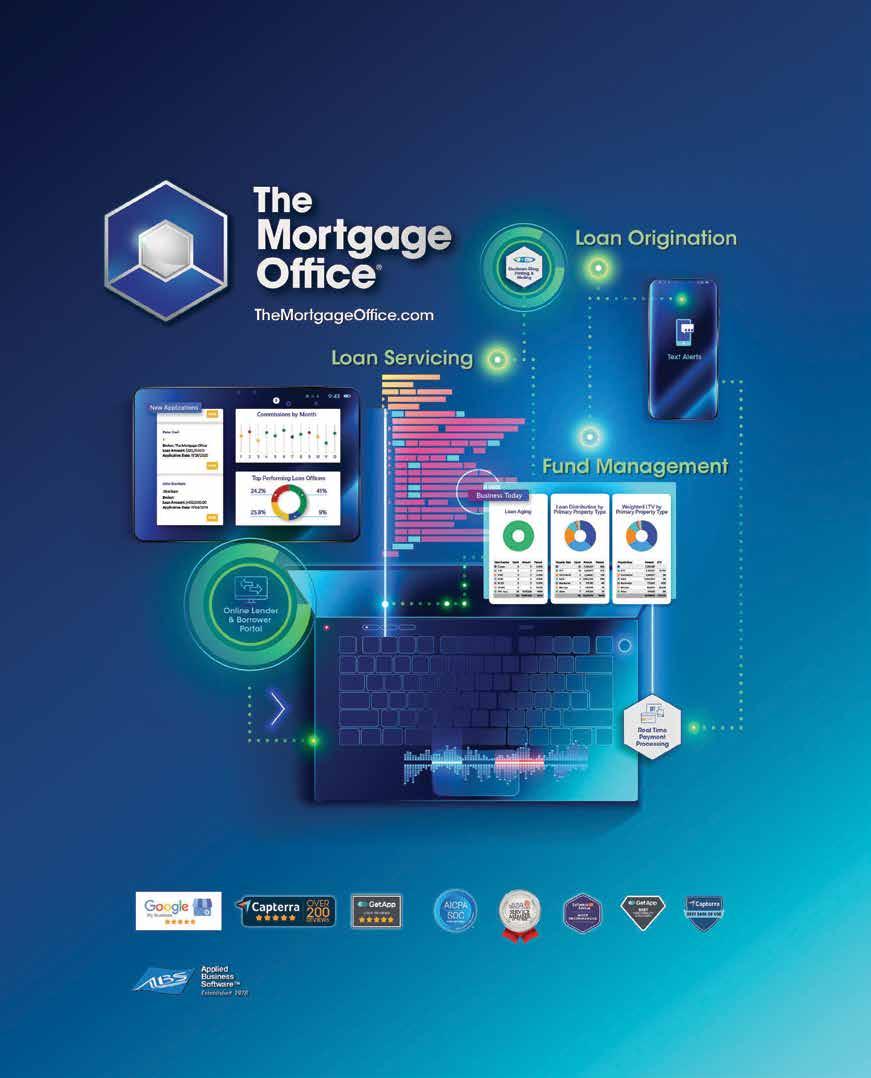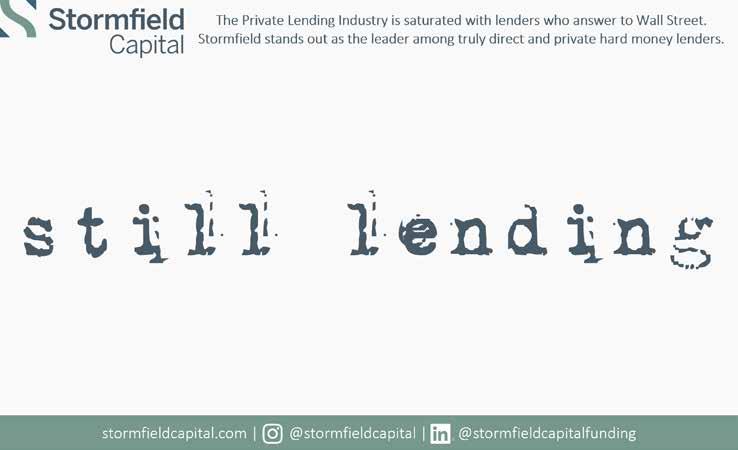ETHICS
Borrower Background Checks
Page 12

ETHICS
Borrower Background Checks
Page 12

Balancing Assets in Your Portfolio
Page 20 OPERATIONS
Understanding
Draw Management Page 80








KAT
HUNGERFORD Executive EditorDAVID RODRIGUEZ Design
CONTRIBUTORS
John Beacham
Katie Bean
Gregory Becker
Daren Blomquist
Alex Buriak
Dana Georgiou
Anthony Geraci
Robert Jayne
Kevin Kim
Stephan Leccese
Mortgage Automator
Rodney Mollen
Susan Naftulin
David Rosenberg
Missy Shermer
Jeff Spiegel
Scott Ward
Shawn Woedl
Nate Zielinski
Ryan Zomorodi
COVER PHOTOGRAPHY
Eugene Krasnaok
Private Lender is published quarterly by the American Association of Private Lenders (AAPL). AAPL is not responsible for opinions or information presented as fact by authors or advertisers.
SUBSCRIPTIONS
Visit aaplonline.com/subscribe.
BACK ISSUES
Visit aaplonline.com/magazine-archive, email PrivateLender@aaplonline.com, or call 913-888-1250.

For article reprints or permission to use Private Lender content including text, photos, illustrations, and logos: E-mail PrivateLender@aaplonline.com or call 913-888-1250. Use of Private Lender content without the express permission of the American Association of Private Lenders is prohibited.
www.aaplonline.com
Copyright © 2023 American Association of Private Lenders. All rights reserved.
No, not for food. Professionally. are you hungry? Eager to dive into your next deal, project, task? Looking for the next opportunity for your business, your career? Are you invigorated, energized, ready?
If your answer is “nope,” take a moment. Right now. What’s the block?
Is there a change you can make—however small—that you’ve been craving? What big changes do you want for yourself that you could start laying the groundwork for today?
We want those changes, whether they’re small or big, for you. We want you to wake up, to hit the ground running, ready to break your “fast,” ready to revitalize yourself both professionally and personally. Because if not now, when?
As we turn the corner to the latter part of 2023, I am incredibly thankful I can say “yes” to being hungry for opportunity and ready for the next thing—due in large part to our members, partners, and supporters.
Many of you have brought your hunger to our door. You’ve brought us the cravings you want for yourself, your peers, and your industry. And that has resulted in our best year yet.
We’ve launched several webinar series to discuss the market, fund management, technology, data, and more. Despite the busier schedule, attendance has skyrocketed. The feedback we receive is “more.” Like you, the industry is hungry – for new ideas, methodologies, and inspiration.
On the magazine front, we’ve heard your feedback that in a world where we’re consuming content in increasingly short soundbites, you want your professional magazine to take the time to fully explore the minutiae of private lending. You want articles running the gamut of trade-related subjects you can sink your teeth into, learn from, and come back to again and again.
And although it’s months away, we have ideas pouring in for what you want to learn and see at our annual conference, which even in these early days, is tracking to be the industry’s largest yet.
“Yes” tends to be infectious in the best possible way. When you want more for yourself and are willing to positively find ways to make it happen, you tend to motivate others along the way.
So, ask yourself: Are you hungry? And, if not, why not? What can you do to change that? ∞
Managing Director, American Association of Private Lenders

Consider these protocols for when to charge default interest and how to develop a default interest policy.
▶ By David RosenbergMany lenders have provisions in their loan contracts to charge a higher interest rate if a borrower defaults on their loan. The default interest remains in effect until the loan is again current. When determining the rate, it’s crucial that private lenders calculate the risk and cost involved in making their small business whole. The following serve as guidelines to determine when, how, and how much default interest to charge.
As a best practice, the American Association of Private Lenders recommends a default interest rate no greater than 18%-25%, with the rate accurately representing the loan’s greater risk and actual loss to the lender.

When determining what default interest to charge, lenders should keep the following in mind.
Compensation for Financial Loss. Default interest compensates lenders for the financial loss they experience when borrowers fail to fulfill their obligations. Private lenders are nearly universally small businesses. They are not banks with depository accounts, and their primary source of business income is loan repayment. Defaults can have a significant impact on their ability to maintain operations, meet expenses, or grow their enterprise. Default interest helps to mitigate this financial loss and ensure lenders can recover their investments.
Risk of Non-Consumer Borrowers. Non-consumer borrowers typically pose higher risks. They often rely on loans to support their operations and growth, and their financial stability is closely tied to market conditions and economic factors. Recognizing and accounting for this higher risk is essential in setting an appropriate default interest rate.
Recovery of Costs. Defaulting borrowers may trigger additional costs for lenders (e.g., legal fees, collections, and administrative expenses associated with resolving the default). Lenders can recover a portion of these expenses by incorporating them into the default interest rate. It is important to strike a balance that is fair to both parties. The rate should be reasonable, considering the borrower’s circumstances, prevailing market conditions, and the actual costs incurred by the lender.
Preservation of Creditworthiness. Defaulting on a loan can tarnish a borrower’s creditworthiness, making it more challenging for them to secure future financing or negotiate favorable terms. The imposition of default interest emphasizes the importance of honoring loan obligations and encourages borrowers to take their repayment responsibilities seriously, thereby safeguarding their creditworthiness.
Behavior. Default interest acts as a deterrent against delinquency and encourages responsible borrowing behavior from non-consumer borrowers. It incentivizes timely payments and adherence to loan terms, promoting a sense of accountability and fostering a healthier lending relationship between borrowers and lenders.
When you, as a lender, find yourself in a situation where you must charge default interest or implement default interest on a first mortgage lien, it is important to follow best practices to ensure fairness and clarity. Here’s a guide on how to handle such a scenario:
Clearly Define Default. Start by clearly defining what constitutes a default in your loan agreement. Specify the specific events or conditions that would trigger the imposition of default interest. This could include missed payments, failure to maintain insurance, or breaching other terms of the loan.
Establish Default Interest Rate.
Determine the default interest rate that
will apply when the borrower defaults. This rate should be clearly stated in the loan agreement and conform to any applicable laws or regulations. It’s advisable to consult with legal professionals to ensure compliance with local regulations.
Provide Notice. When a borrower defaults, promptly provide written notice to the borrower specifying the default and the imposition of default interest. Include details such as the amount owed, the new interest rate, and the timeframe within which the borrower must rectify the default to avoid further consequences.
Document Communications. Keep thorough records of all communication with
the borrower regarding the default and the implementation of default interest. This includes sending notices via certified mail or any other traceable method to ensure you have evidence of providing timely and accurate information. This is why lenders often opt to have a licensed and reputable third-party servicing company handle their portfolio. Using a vetted third party helps remove the daunting task of sending all proper correspondence and mitigates some of the necessary human capital it would take to stay current and compliant with state and federal regulation.
Transparency and Clarity. Maintain transparency and clarity throughout the
process. Clearly explain to the borrower why default interest is being charged and how it is calculated. Provide an itemized breakdown of the charges, including any applicable fees or penalties, to ensure the borrower understands the consequences of defaulting.
Compliance with Applicable Laws. Ensure that your actions align with local laws, regulations, and any governing bodies that oversee lending practices. Familiarize yourself with usury laws, interest rate limits, and any specific requirements related to default interest in your jurisdiction.

Consider Alternatives. Although charging default interest may be necessary in some cases, it’s worth considering alternatives.
Fidelis Investors is a dedicated strategic capital partner for private money lenders throughout the United States. Our platform helps lenders, like you, raise capital by e ciently selling loans. Since 2009, the Residential Investment Team has successfully transacted in over $3.0 billion of whole loan purchases.

For instance, working with the borrower to establish a modified payment plan or exploring options for loan restructuring could help avoid default interest altogether. This is why you have begun to hear and/or see some small, mid, and even larger lending institutions implement asset management or loss mitigation teams. Depending on the geography of any one lender’s portfolio, loss mitigation to achieve a reperformance or a quick return of the hard asset is a much more economical solution.
Seek Legal Advice if Necessary. If the situation becomes complex or legal disputes arise, seek legal advice from professionals experienced in lending and mortgage laws. They can provide guidance on the best course of action and ensure compliance with legal requirements. Further, lean on your third-party servicer to recommend legal resources and recent regulations pertaining to the proper course of action when pursuing lawful default. Remember, these best practices are general guidelines, and it’s important to consult with legal professionals and adhere to specific legal and regulatory requirements in your jurisdiction. By following these best practices, you can effectively charge default interest on a first mortgage lien while maintaining transparency, fairness, and compliance with legal requirements.
When developing your default interest policy consider these key factors:
Legal and Regulatory Compliance.
To ensure you stay informed of usury
laws, guidelines, and standards, there are several best practices you can follow, including the following:
Seek legal consultation from legal professionals experienced in lending and finance laws. They can provide guidance specific to your jurisdiction and help you understand the nuances of usury laws and regulations. Regularly consult with them to stay informed about any updates or changes in the legal landscape.

Familiarize yourself with regulatory bodies responsible for overseeing lending practices in your jurisdiction. Stay updated on their publications, guidelines, and enforcement actions related to usury laws. These organizations often provide resources and updates that can help you understand and comply with the latest standards.
Join relevant industry associations or organizations that focus on lending and
finance. These associations often provide valuable resources, training programs, and networking opportunities that can keep you informed about usury laws and best practices. Attend conferences, webinars, and seminars organized by these associations to stay up to date with the latest developments in the field.
Invest in your professional development by attending courses, workshops, or webinars that specifically cover usury laws, lending regulations, and compliance standards. These educational opportunities can provide you with valuable insights and ensure you remain knowledgeable about changes in the industry. Conduct regular research on usury laws and related legal frameworks. Familiarize yourself with relevant statutes, case law, and legal commentary. Online legal databases, legal publications, and law libraries can serve as valuable resources for staying informed about the
latest interpretations and applications of usury laws.
Networking and Collaboration. Engage in professional networks and forums where lending professionals gather. Participate in discussions, ask questions, and share insights related to usury laws and compliance. Collaborating with peers and industry experts can provide practical perspectives and help you stay informed about emerging trends and challenges. Government Resources. Government agencies and departments responsible for regulating lending practices often provide resources, publications, and updates on usury laws. Visit their websites, subscribe to newsletters, and follow their social media accounts to receive timely information and notifications about changes in regulations.
Industry Standards and Best Practices. Research industry standards and best practices regarding default interest. Look into how other lenders handle default interest and consider adopting practices that are widely accepted and proven to be fair and reasonable. This helps you establish a policy that is consistent with market norms. Risk Assessment. Evaluate the risks associated with defaulting borrowers and the potential financial impact on your institution. Consider factors such as the borrower’s creditworthiness, loan-to-value ratio, and the overall health of the real estate market. This assessment helps you determine an appropriate default interest rate that balances your risk exposure while remaining fair to the borrower.
Reasonableness and Proportionality. Strive to set default interest rates that
are reasonable and proportionate to the borrower’s default. Charging excessively high rates may be seen as predatory or unfair. Consider the additional costs and risks incurred as a result of default and ensure the default interest rate reflects a genuine reflection of those factors.
Transparency and Communication. Clearly communicate your default interest policy to borrowers. Include detailed information about the default interest rate, how it is calculated, and the circumstances that trigger its imposition. Make sure the policy is written in clear and understandable language to avoid any confusion or misunderstandings.
Consistency and Non-Discrimination. Apply your default interest policy consistently and without discrimination among borrowers. Treat all borrowers equally, ensuring the policy is applied uniformly regardless of race, gender, or other protected characteristics. Consistency and fairness promote trust and minimize the risk of legal challenges.
Review and Adaptation. Regularly review your default interest policy to ensure its effectiveness and relevance. Monitor changes in the lending industry, regulatory landscape, and economic conditions to identify any necessary updates or improvements. Staying proactive and adaptable helps you maintain a policy that is responsive to evolving circumstances.
Documentation and Records. Maintain thorough documentation and records of your default interest policy, including any updates or revisions. Keep a record of borrower acknowledgments, signed agreements, and any relevant communication regarding the
policy. This documentation serves as evidence of transparency and can be valuable in case of disputes or legal inquiries.
By considering these factors when developing your default interest policy, you can establish a fair, compliant, and transparent framework that protects your institution’s interests while maintaining a balanced approach toward borrowers in default. By incorporating these best practices into your routine, you can stay well-informed about usury laws, guidelines, and standards. Remember, it is crucial to consult with legal professionals for specific advice tailored to your jurisdiction and to regularly update your knowledge to ensure compliance with applicable laws and regulations. ∞
DAVID ROSENBERG
David Rosenberg is the co-founder of Futures Financial, a private lender based in Orange, California. The company focuses on business-purpose loans for residential, multifamily, fix and flips, ground-up construction, and bridge loans nationwide. Futures Financial is a balance sheet lender. Further information is available at www.FuturesFinancial.com.


By understanding and addressing background check best practices, lenders can navigate the process effectively, make informed lending decisions, and maintain compliance with applicable laws.
▶ By John Beacham and Kevin KimBackground checks can be an important tool in business-purpose lending, providing lenders with critical information to make informed decisions about a borrower’s creditworthiness and character. These checks help lenders evaluate various aspects of a borrower’s financial history, business operations, and personal background. They can also provide a variety of other useful information such as criminal, legal, and regulatory history. However, it is important for lenders to exercise judgment when interpreting the information obtained from these checks, ensuring it is relevant to the borrower’s credit profileand does not result in any unintended bias in the lending decision.
Lenders may consider several factors when assessing criminal background check
results. Here are many of the flags that can show up, along with what lenders should consider when evaluating their impact on an underwriting decision. Convictions. Considerations include status, timing, and severity.
Status . First, only convictions should be evaluated in the context of a credit decision. Unsubstantiated allegations or charges without a guilty verdict should not be used to make lending decisions, because they could unfairly impact the borrower.
Timing . The recentness of a conviction also should be considered. More recent convictions may indicate ongoing or unresolved legal issues that could affect the borrower’s ability to fulfill their financial obligations. Crimes committed further in the past may be less relevant, because individuals can rehabilitate and
demonstrate improved responsibility over time.
Severity. The seriousness of a crime should also be considered. Felonies typically (but not always) indicate a more serious crime than misdemeanors.
Financial crimes. Financial crimes, such as embezzlement, arson, or fraud relate to a borrower’s financial integrity and may pose a higher risk to lenders. These offenses may be given greater weight in the credit decision because they could indicate a higher potential for financial misconduct.
Bankruptcy. Another common red flag is a history of declaring bankruptcy. Bankruptcy indicates a borrower has faced severe financial difficulties in the past, potentially suggesting a higher risk of defaulting on future obligations.
Judgments. Multiple or large judgments against a borrower may also raise concerns for lenders. Judgments occur when a court orders an individual or business to repay a debt owed. The presence of multiple judgments may suggest a pattern of financial irresponsibility or an inability to meet financial obligations promptly as well as a willingness to litigate rather than repay creditors.
Fines and penalties. Adverse regulatory actions may also have a negative impact on a borrower’s creditworthiness. These actions may include sanctions, fines, or penalties imposed by regulatory authorities due to noncompliance, unethical practices, or other violations.
Liens. Unresolved tax liens may be another concern. Liens are imposed by tax authorities when an individual or business fails to pay their tax obligations. Lenders may view unresolved liens as a sign of financial instability and a potential encumbrance on the borrower’s assets. Such liens may undermine a borrower’s ability to repay loans.
Remember, it is crucial for lenders to maintain a balanced approach. Each borrower’s circumstances are unique, and the interpretation of background check information should be done judiciously. It is essential to consider the overall credit profile of the borrower, including factors such as their financial stability, credit history, and business operations. Lenders should view background checks as a complementary tool to assess risk and inform
lending decisions rather than as the sole basis for judgment. Care should be taken to ensure results are evaluated in a way that does not result in any unintended bias in the lending decision.
Each lending institution may have its own risk tolerance and lending policies. Some lenders may be more willing to work with borrowers who have experienced setbacks, while others may adopt a more conservative approach and prefer to avoid borrowers with certain negative indicators.
Although background checks are undoubtedly a valuable resource for evaluating the creditworthiness of borrowers, lenders should exercise sound judgment when interpreting the results. By considering background checks in the broader context of a borrower’s credit profile, lenders can make well-informed decisions.
It is essential for lenders to understand the risks involved in conducting background checks and ensure compliance with relevant regulations. When developing your evaluation matrix with the considerations outlined previously, keep in mind the following:
GLBA privacy regulations and commercial purpose loans. Under the Gramm-Leach-Bliley Act, financial institutions are required to protect the privacy and security of customers’ nonpublic personal information. However, these privacy regulations do not apply to business- or commercial-purpose loans. Although GLBA safeguards personal information in the context of consumer transactions, it does not impose similar requirements

for commercial loans. Lenders should be aware of this distinction when conducting background checks for commercial mortgage applications.

State privacy laws and credit/background checks. State privacy laws may vary regarding the restrictions placed on lenders when obtaining credit reports or conducting background checks for commercial mortgage applications. However, many state privacy laws do not restrict a lender’s ability to access these reports or perform background checks when evaluating applications for credit extensions. To ensure compliance, lenders should familiarize themselves with the specific state laws applicable to the jurisdictions in which they operate.
FCRA and permitted purposes. The Fair Credit Reporting Act (FCRA) governs the collection, use, and dissemination of consumer credit information. FCRA specifically allows lenders to obtain credit reports and background checks for a permitted purpose, which includes extensions of credit or purchases of closed loans. Lenders must ensure they comply with FCRA requirements (e.g., obtaining permissible purpose certifications from credit reporting agencies, using the information only for intended purposes, and providing adverse action notices when required).
Market practice and obtaining permission. Although certain regulations allow lenders to access credit reports and perform background checks for commercial mortgage applications, it is considered a market practice and good business ethics to obtain permission from the borrower or principal or guarantor. This permission
should be documented and kept on record to demonstrate compliance with industry standards and to establish a transparent borrower-lender relationship. It also helps to mitigate any potential disputes or concerns regarding the invasion of privacy during the application process.
The practical result of this is the lender is now evaluating the individuals associated with the borrower entity. If certain discriminatory practices or patterns appear (based on protected classes such as age, gender, race, or religion), then it could potentially open the lender to aggressive plaintiff litigation. Although the law is on the lender’s side, it would still be a costly case to defend. It would also tarnish the lender’s reputation in the marketplace.
Running background checks and reviewing credit reports are important steps in evaluating commercial mortgage applications. Although GLBA privacy regulations do not apply to commercial-purpose loans and state privacy laws generally do not restrict lenders in this context, lenders must still adhere to Fair Credit Reporting Act (FCRA) requirements. This includes ensuring the permissible purpose for accessing credit reports and background checks and obtaining permission from the borrower or relevant parties. By understanding and addressing these risks, lenders can navigate the background check process effectively, make informed lending decisions, and maintain compliance with applicable laws and industry practices. ∞
John Beacham is the CEO and founder of Toorak Capital Partners, a leading investment manager dedicated to investing in small-balance, business-purpose residential, multifamily, and mixed-use loans, including residential bridge loans. Toorak acquires loans from leading loan originators and manages all aspects of its investment portfolio, including loan sourcing, pricing, underwriting, acquisition, and asset management.
Kevin Kim is a corporate and securities law attorney with AAPL’s general counsel, Geraci Law Firm. Kim focuses on real estate, including private placements and alternative investments for private lenders, real estate developers, and other entrepreneurs. His work includes seeing that clients are compliant with applicable securities laws, structuring strategic partnerships, and creating innovative solutions.


Third in a series detailing how one lender navigated the daunting task of establishing a private money fund.
▶ By Gregory BeckerIthought we would be further along our fund establishment journey than we are. When my partner Eric Saiki and I obtained our Fund Manager I and II certifications from the American Association of Private Lenders (AAPL), we were raring to go. Delays have set in, however. Fortunately, the delays are a result of our desire to put this fund together under our terms while balancing our legal careers and family lives. The old saying is never truer, “If you do not have time to get it right the first time, where will you find the time to get it right the second time?”
By the end of the 2022 AAPL annual conference in Las Vegas, we had the knowledge necessary to start a fund and manage it along with its investors. The large bandwidth issues included establishing a management entity, establishing a fund compliant with securities laws that maximize tax opportunities, licensing,
marketing, technology, and ensuring compliance with AAPL’s Code of Ethics.
Phase two of our journey involved drilling down on the issues we identified in the first phase. We interviewed securities lawyers, researched licensing issues, and researched and established the management entity. In addition, we interviewed several software providers in the following three spaces: origination, client relationship management, and servicing and investor relations. We also identified the strategy of white label lending, a pathway we though would allow us to originate loans and build the company on parallel paths.
Phase three is upon us. Our two main goals for this phase are (1) to begin originating through white label lenders and (2) to work with securities lawyers to establish the fund. We had the white label lenders identified and a securities law firm in mind. We had just one minor matter to address and then we’d be off to the races—or so we thought.
The minor matter was our website. What seemed like a simple project took on a life of its own. The challenges are mainly because we treated the website as an extension of ourselves. It will be the first impression of us for many, and we all know the old adage that one never has a second opportunity to make a good first impression. We therefore set our standards high and opted out of creating a quick and easy one-page website. Ultimately, our website consumed us, bogged us down, and prevented us from focusing on revenue-producing activities.
Our initial strategy was simple. We used one of the many website-building services and did it ourselves. We worked on the content together and nurtured our joint vision. As a result, we will not be beholden to website developers. In the future when we need to make the many
intended changes, we will do so swiftly and efficiently.
Some might argue that developing a website on our own was “penny wise and pound foolish.” For Eric and me, it was never about the monetary outlay for a website developer. Websites can be professionally developed for a very reasonable price these days. Personally, I have been known to spend more on wine over a short weekend in Paso Robles.
For some, a website is a mere presence—a static page in the cyber universe. We want a site that can act like a town hall for us for years to come, one that is constantly
evolving with a blog, articles, testimonials, and examples of recently funded transactions. We want a basic and functional website that will be our living, breathing connection to the cyber world and will stand the test of time, not something that will merely help us move from point A to point B.
Although I am proud of the site we have built, I do regret not hiring a professional, including our white label providers’ offers to create a site for us. They could have created a basic landing page for us by a white label lender for free. In fact, for a small fee, they would have put together a more complex website while we built our own uber site.

So, yes, we love the site we completed ourselves and that we can manage ourselves. Nonetheless, we realize now that we would have gotten off to a faster start if we’d spent more of our valuable time originating instead of wasting it on something that could have been outsourced.
Adding insult to injury, as we were ready to go live with our website, we discovered a problem with the white label strategy. The proprietary origination software utilized is not to the level of the origination software created by providers who specialize in private lending software. The origination software we originally researched for our own use in the fund is much better than
the white label software because the former is built for private lending and the latter is not. On a piecemeal basis, the white label software can complete the job; however, this basic software will create much more work for us. Those looking to be a long-term player need to partner with one of the software companies specializing in this space.
One bright spot in Phase three is the client relationship management software we found. As you may recall, we spent a lot of time in Phase two trying to find an all-in-one option for originations, CRM, and servicing, ultimately realizing that to get the advanced features we needed for each function, we had to find separate platforms for each one.
The platform we selected for CRM allows us to communicate with investors, referral sources, borrowers, and any group we see fit to create. The software is so powerful that our account executive can set up an entire annual marketing campaign in hours. On January 1 of each year, our marketing campaign for the year will be set up. Using emails and posts on Facebook, Instagram, Linked In, and Tik Tok, it will send out holiday cards, birthday cards, jokes, recipes, newsworthy items, and much more. Our outreach will be constant and interesting. If we want to send our clients information on products or success stories, we can do that very easily as well.
One thing to consider when selecting a CRM is how it integrates with the software you’re using to maintain current contacts. Consider
finding either a CRM that integrates with what you currently use or one that can stand alone (one that will fulfill your marketing needs while acting as the central hub for all your contact information).
As we complete Phase three of our journey, we are finalizing licensing items we can complete without the help of securities counsel. We are also designing a logo.

Once the site goes live and the white label is plugged into it, we will let loose our marketing campaign and begin originating loans through the management entity. Once we begin originating loans, our next call will be to securities counsel.
We anticipate Phase four to focus on securities counsel and loan origination, if all goes well. Once the fund is in place, the real fun will start: We begin working with investors and helping them achieve success. ∞
Gregory Becker is a wills and trusts lawyer as well as a mortgage broker with an office in Redondo Beach, California. With more than 20 years’ experience in these areas, Becker is looking to start a PLF and researching various private lending associations.
As a law school student he wrote for the school newspaper and now publishes a monthly article in his current city’s local magazine.










Real Estate Investment Trusts (REITs) have become a popular option for investors. As a fund manager, it’s important to ensure your REIT fund is properly balanced between different asset classes such as single-family rentals (SFRs), multifamily properties, and general use commercial (GUC) properties. Balancing your portfolio is key to maximizing returns and minimizing risk. It also makes the marketing of it much more attractive in the current real estate environment.
Single-family rentals. The growing demand for rental properties has made SFRs
an increasingly popular option for many investors. With more people choosing to rent rather than to buy, rental payments can offer investors a stable source of income. These properties are also attractive because they tend to require less upkeep, management, and maintenance than multifamily properties. They are also quicker to underwrite and assess for risk, not to mention sell to the secondary market if that is part of your focus.
Multifamily properties. On the other hand, multifamily properties offer the potential for higher returns, because you can generate multiple rental incomes from a single property. With more units to rent out, there is potentially a lower risk of
vacancy, meaning a more stable income stream for investors.
With that said, multifamily properties are generally more expensive to acquire and maintain, which means they require a larger investment upfront. They still are a smart focus of your fund if they are placed in the correct concentration limits, they aren’t massively massive outdated, or they don’t require improvements that have been delayed. If multifamily is going to be a vertical for your fund, make sure you have a solid team member with experience in this asset class who can drive this program. There’s nothing worse than having a large property with underperforming rental income and needing maintenance that has been deferred. This class of investment needs smart
Asset diversification is key to maximizing your returns and minimizing risk and makes your portfolio much more attractive in the current real estate environment.
eyes and wise underwriting, but it can pay off well if added to your fund correctly.
General Use Commercial. GUC properties offer a different set of benefits, including retail spaces with long leases, mixed-use residential/retail, offices, and multifaceted warehouse types, which are leased out to businesses rather than individuals (or a combination of both). The combination of people moving to newer areas and a lack of inventory provides an opportunity to back a builder with solid, repeat loans and fast exit turnarounds. These properties can generate higher rental incomes if held. Being newer and more attractive, they require little to no rehab or maintenance.
Focusing on spec home builders and those looking to do smaller tract sizes with staged phase releases can offer a solid, longer-term repeat system for your fund and make it easy for investors to understand. However, tenants may be more likely to default on their leases during times of economic volatility. In that case, GUC properties can require more maintenance
or redesign to keep tenants satisfied or newly leasing. The question to always ask is: “If the nail shop closes down, what else can we do with this spot?”
Balancing your REIT fund among these various asset classes can help you achieve a diversified portfolio that offers stable returns and lower risk. Achieving this balance can be challenging, especially for new fund managers. A great rule to follow is: “Too much of any one thing isn’t good for you.” So, embrace diversification and be mindful of concentration limits you set with your team and your counsel.

Here are some general considerations for diversifying a fund among different asset classes.
Ratio goals. As a best policy, consider following the rule of 70% residential, 20% multifamily, and 10% GUC. Obviously, this formula can be adjusted and should reflect
your individual expertise. That said, this is a common and solid baseline.
Your experience. If you don’t have experience with an asset class, is it better to avoid it, hire someone who does, or start small with one or two properties? If you don’t have a solid level of experience with a certain asset class, it is sometimes best practice to involve a third-party expert to back your underwriting and asset valuation.
Asset location. Consider the markets in which these asset classes are doing particularly well. Also consider which asset classes are better suited to a certain market. Further, to get a more granular feel for a particular property, some lenders actually walk a property, street, or local area when considering a loan. If you can’t walk the actual property, enlist a local agent or expert to send video of the general area to help you evaluate the overall “picture of risk.”
Investor interest (and/or secondary market interest, if selling the paper). The best way to evaluate investor interest in the market is to stay current on market trends, job corridors, school zones, and what the local real estate groups are moving easily. Local markets are local . Those who work in those markets every day are usually your best source of what is hot and what is not.
The industry abounds with resources to assist you as you make decisions about your portfolio. Here are a few considerations for continuing your education and building your knowledge of the industry.
Get a mentor. Mentorship can be invaluable. Experienced fund managers can offer insights into the industry, provide guidance on investing strategies, and help identify potential pitfalls and opportunities. Never stop learning! Smart and experienced fund managers pursue knowledge and trends as hard as they pursue investors. Mentorship can also help fund managers stay up to date with changes in the market and emerging trends. For example, with the rise of remote work, some investors may be turning away from multifamily properties in urban areas and looking for properties in suburban or rural areas. A mentor can help a fund manager identify these emerging trends and adjust their investment strategy accordingly. Keeping your eye on these properties in real time and in person is also best practice. It helps to forecast issues with the location and property that may be missed by phoning it in. Your investors will thank you!
The first place to start looking for real talk, real education, and real advice is with AAPL. Beyond that, there are many very strong organizations in our space that hold events and conferences with educational programs. A few examples are the National Lending Experts, Think Realty, and the Family Office Club.
Look into events at your local level, too, to find out who is doing what you want to do in the areas you want to specialize in. Take time to talk to those people. You will know quickly whether a company or individual aligns with your focus and outlook. “Never stop learning” as my old mentor would say.
Seek out other professionals in the industry. Fund managers should also consider working with real estate professionals like brokers and property managers. These
professionals can provide valuable insights into the local real estate market, help identify potential investment opportunities, and offer advice on property management. One key challenge for fund managers is identifying the right properties to invest in as they underwrite. This requires a deep understanding of the local real estate market as well as an understanding of the specific needs and preferences of potential renters or lessees. Real estate professionals can help fund managers navigate these complexities and make informed investment decisions. A good policy to follow is that you “never want to be a mile wide and an inch deep.” Know your market and your asset class—this will save the day more than once.
Another important consideration is the management of the properties themselves. Property management can be complex and time-consuming, especially for multifamily properties or GUC properties (inspections, maintenance, rental payment collection, etc.). Working with experienced property managers can help fund managers ensure their properties are well-maintained, tenants are happy, and rental income is maximized. One person cannot do it all, and your investors will feel more confident knowing you are paying attention to every detail.
It’s also important to regularly assess and rebalance your portfolio to ensure it remains aligned with your investment goals and objectives. Every 30, 60, 90 days is a good review timeline for new funds; every 120 days to six months for older funds. As the market changes and new opportunities emerge, you may need to adjust your
investment strategy accordingly. This can be challenging, but it’s crucial for ensuring your fund remains profitable long term.
Communicate monthly with your investors, informing them about market trends, your thoughts, and any potential new focus. Doing so speaks volumes to your professionalism and dedication to operate the best fund or REIT you can.
Finally, as a fund manager, it’s important to have a clear understanding of your investors’ goals and objectives. This will help you identify investment opportunities that align with their needs and ensure that your fund remains attractive to potential investors.
Balance is always best when it is done from the front and the back. Look at all sides as well as long-term results as you march forward in today’s ever-changing investment world. ∞
SCOTT WARD
Scott Ward has more than 20 years of private money experience, ranging from loan origination to fund management. As an investor himself, Ward understands the process and pursuit of investment properties, and he prides himself on being a fan of the rehabber and builder. Currently based in Dallas, Texas, Ward’s main focus is on the ground-up construction, fix-and-flip, and multifamily markets.

Streamline your private and commercial loan operations from application to servicing with a modern, white-labeled experience.
CRM: Manage leads and referral partner relationships with built-in tools for email, SMS, dialers, and more.
LOS: Close more loans faster with webforms, doc/file upload portal, and doc generation engine.
Marketplace: Match your loans with lenders based on eligibility across verticals like bridge, fix & flip, construction, DSCR, CRE, SBA, equipment, term loans, line of credit, MCA, and factoring.
Price Engine: Industry’s first automated pricing engine for bridge, fix & flip, construction, DSCR, and business loans.
Loan Servicing: Manage all loan servicing activity including draws, payments, escrows, payoffs, fractional investors, and more.
Turnkey, cloud-based and fully customizable platform – no software download needed.
Multi-level broker channels for correspondents, net branches, and referral partners.

Prepopulate loan docs, forms, and disclosures in Word or PDF with unlimited e-signatures.
Third-party integrations and APIs for credit, AVM, BPO, income/asset verification, inspections, and more.
We help brokers and lenders scale their business with our software.
Understanding appropriate coverages for the situation and working with reputable agents goes a long way to protect both the lender and the borrower.
▶ By Shawn WoedlInsurance, often viewed as the less glamorous side of a business transaction, tends to be a topic that receives minimal attention. Yet, its significance cannot be overstated: Insurance is a crucial part of mitigating risk. By including appropriate coverages and limits as well as recommending reputable agents or agencies, you can significantly reduce both your exposure and that of the borrower. Your insurance lending requirements should be one of the first things you provide to a potential borrower. Regardless of property type, always require the borrower to carry insurance that meets or exceeds the outstanding loan. That means the loan value must be the minimum of what the property is insured for. If the outstanding
loan is $150,000, do not let the borrower insure to $140,000.
To ensure the borrower keeps coverage active, you should be listed as the mortgagee. If you should be listed on any payout from the insurance company following a property loss, you must also be listed as loss payee . Require that you are listed as Additional Insured (AI) on your borrower’s liability coverage as well. These stipulations guarantee you will be notified if the borrower’s coverage is in jeopardy of lapsing for underwriting, non-payment, or any other reason, including a coverage cancellation request from the borrower. When it comes to property coverage, consider requiring the following, regardless of property type:
▶ Special Form coverage (Special has the least exclusions, therefore minimizing your exposure.)
▶ Replacement cost (Actual Cash Value is a depreciated amount and opens the door for the borrower to experience financial hardship that could jeopardize their ability to repay the loan.)
▶ Add-ons such as earthquake or flood
▶ Other structures (if applicable)
Let’s take a quick look at some of the essential policies and limits to consider specific
to fix and flip, ground-up construction, and rental properties.

Fix and flip. Builder’s Risk is a policy form that covers structures under construction or renovation. The outstanding loan value should be the minimum requirement for property coverage. On the liability side, ensure the borrower’s policy is at least $1 million per occurrence/$2 million aggregate. It’s important to note that almost everywhere your borrower goes, a Builder’s Risk policy is property only unless the borrower specifically requests premises liability coverage as well. Not only is this exposure for the borrower, but it is also exposure for you. If your borrower gets sued for $1 million, what are the chances they can pay back their loan?
You may also consider requiring the following with regard to the liability policy:
▶ Ensure the carrier underwriting the premises liability policy is aware the location is under renovation. Properties undergoing renovation are more susceptible to liability losses that arise from slip-andfall injuries resulting from uneven surfaces, debris, trespassing, etc. If the carrier was not made aware of the location’s renovation status, they may have grounds to deny a claim
▶ Any general contractor (GC) hired must have their own liability coverage, and the borrower must be listed as AI. If the contractor faces a lawsuit due to negligence and the borrower
becomes involved, the liability of the contractor (including defense expenses) would also extend to the borrower. The GC’s coverage may cover losses for negligent hiring or construction accidents. Defense costs must be outside the per occurrence and annual aggregate limits.
Ground-up construction. This property type also involves the Builder’s Risk form, but it is handled a little bit differently, because the borrower will not have two separate limits from the get-go. The most common strategy is to require the borrower to insure to the anticipated build cost from day one. However, if the borrower is insured on a monthly reporting form (a program that allows the borrower
to update and adjust the value of the property on a month-to-month basis) and the lender is OK with it, the carrier will sometimes allow the borrower to increase the value as time goes on.
For new construction on Builder’s Risk, coverage is always limited to invested capital at the time of loss. Let’s say the borrower expects the end build to cost $1 million, so they insure to that value. If just the frames have been built and a fire burns them to the ground, the borrower isn’t going to get $1 million. They can get whatever capital has been invested at the time of loss. This is why lenders will often fund these deals in percentages or over time. On the liability side, the recommended
requirements remain the same as those mentioned under fix-and-flip properties
Rental properties. Depending on how deep you want to go, there are quite a few things to look out for when it comes to insurance on your borrower’s rental property. In addition to the items listed below, you may also want to look at the deductible structures to make sure the borrower isn’t over-extended.
For property coverage, consider requiring the following, if applicable:
▶ Loss of rents (at least six months’ worth)
▶ Renters insurance (the caveat being there is no way for you to track that this coverage stays in
force; you cannot be listed as an Additional Interest on this policy)

▶ Contents coverage (for vacation rentals)


On the liability side, consider requiring the following:
▶ $1 million per occurrence/$2 million aggregate


▶ Defense costs outside the limits
▶ Canine liability or coverage for dog bites
▶ Carbon monoxide coverage
▶ If the property is more than two stories, add an additional $1 million of coverage (a third floor changes the means of egress and your exposure)

Settlement method: Replacement cost is required, with the insured building value being the amount of the loan, at minimum.
Coverage form: Special form property coverage is required. Basic or broad coverage forms are not acceptable.
Coinsurance: The policy must not include a coinsurance clause.
Deductible: The maximum AOP (all other perils) property deductible allowed is $5,000. Exceptions are allowed for the perils of wind/hail, named windstorm, and theft and VMM (Vandalism & Malicious Mischief), if needed.
Named windstorm (hurricane): This coverage must be included for all locations located in a tier 1 or 2 county. The maximum deductible allowed for the peril of named windstorm is 3% of the total insured value at the location, or the AOP property deductible, whichever is greater.
Loss of rents: This coverage is required for all occupied locations.
Flood coverage: This coverage is required if the property is located in a high-hazard flood zone.
Earthquake coverage: This coverage is required if the property is located along the New Madrid fault line or in the following states: California, Washington, Oregon, Alaska, and Hawaii.
Coverage must be written by a carrier rated “A” or better by A.M. Best.
“ABC Sample Lender” must be listed as Mortgagee and Lenders Loss Payable as follows:
ABC Sample Lender, LLC
ISAOA/ATIMA
123 Main Street, City, State, Zip Code
Premises liability coverage must be obtained with the minimum coverage limits of $1,000,000 per occurrence and a $2,000,000 annual policy aggregate limit per location. No shared limit policies are permitted.
Personal liability policies are not acceptable.
The maximum liability deductible allowed is $2,500.
If the location is undergoing renovation and the borrower is a general contractor and completing the renovation themselves, either (1) a general liability policy must be obtained (in lieu of the premises liability coverage) with no exclusion for products and completed operations or (2) the borrower must provide proof of coverage for their general contractor’s liability in addition to their premises liability coverage.
For locations exceeding three stories, an additional $1,000,000 of liability coverage per story is required in the form of an excess liability or umbrella policy (due to the change in means of egress).
“ABC Sample Lender” must be listed as Additional Insured on the Premises and Liability policy as follows:
ABC Sample Lender, LLC
ISAOA/ATIMA
123 Main Street, City, State, Zip Code
Any insurance carrier your borrower works with should be AM Best “A” Rated or better. This rating system considers the strength of the company, its ability to pay claims, and its outlook. Meaning, for the last two years, has the company been insuring profitable businesses and have they been paying out what was expected or less on losses? Do not allow the borrower to go through an unrated or under A- carrier
If you really want to dive in deep, you can look into the insurance agent or broker the borrower is going through. Make sure they are licensed to do business in the state the property is in and obtain proof of their Errors & Omissions coverage. It is wise to advise your borrower to look for agents familiar with the aforementioned types of policies and coverages. Agents or agencies with multiple markets and experience in this line of business have a better chance of finding cost-effective coverage with policies that minimize exposure.
If you have a relationship with an agent or agency, they can likely provide you with useful information about the premises itself, the surrounding area, and loss history for an existing property (if they have access to it). In some instances, the agent/agency can even provide specifics on rebuild costs and potential return on investment.
Some insurance providers will assist you in assembling an insurance lending
requirements list. A property in Florida has different needs than a property in Colorado. Blanket requirements do not always work and can leave you exposed.
It will always be favorable to you if the agent the borrower is working with also offers a lender-placed option. If the borrower were to default on their insurance, leaving you exposed, you would either let it ride and hope a loss doesn’t occur or scramble to find coverage quickly. With a lender-placed alternative, the property can quickly move to a policy that covers your interest.
Although you can require anything when it comes to coverage (because those are the conditions of funding the loan), you should never require your borrowers to use a particular agent, agency, or carrier. If a borrower feels their claim wasn’t settled favorably and you required them to go through that agent or carrier, you can be dragged into a lawsuit. “Highly recommending” is one thing, but requiring is another. Consider including a note like the following on your insurance lending requirement document: “Please feel free to shop your insurance with [Agent Name].”
In a lender-borrower relationship, it is crucial to strike a balance between protecting your interest and maintaining requirements that allow the borrower to gain cost-effective coverage. Insurance should not just be an item for you and the borrower to check off your lists at closing. The more time you can give a borrower’s agent to secure sufficient coverage, the more markets they can shop,
the more aggressive pricing they can get, and the better coverage options they’ll be able to find. Insurance is the most common thing that delays a deal or prevents it from closing altogether. Don’t let inadequate coverage create stress, waste time, and cost you more money. Make insurance a focal point from day one
Shawn Woedl, CEO, joined National Real Estate Insurance Group in 2014 and has been instrumental in growing NREIG into the largest insurance program in the country for residential investment properties, insuring nearly 140,000 locations today and growing. Through his efforts, the NREIG program has expanded to accommodate investment properties up to 20 units, vacation rentals, and non-performing notes, just to name a few.
He is responsible for overseeing all aspects of the agency, specifically focused on maintaining strong carrier and industry relationships, developing new and innovative product offerings, and managing internal sales and service processes.

These guidelines will help you successfully navigate your capital options as you set up and grow your private lending business.
▶ By Anthony GeraciSo, you decided to become a private lender—but that’s about all you’ve decided. There are so many “flavors” of private lenders, each doing hugely different things, that you may be overwhelmed with the choices.
This primer will help you consider everything you can do as a private lender—from the capital side.
First things first. You have to decide whether you are going to use your own capital or raise it.
Using your own capital. If you use your own capital, you will have the
most control—and the most options. You get to “paint the box” with whatever deals you want to fund. Ideally, you will have a strong sense of the deal or an underwriting background as part of your capital-raising repertoire.
So, what are some of the options using your own capital affords you?
As noted, you can create your own deals. But what if you’re tapped out of time? You can always buy (or fund) someone else’s deal.
Raising capital. What if your deal flow is much larger than your capital? You have a couple of options.
One possibility is to leverage the capital that you do have. Leverage occurs when you take your capital and the assets you’ve originated and obtain a loan secured
against them. Using your capital in this way allows it to become a much larger pool of capital you can tap into. It’s called leverage because you use your capital as a lever to a new level.
Another possibility for raising capital is to obtain a warehouse line . What’s a warehouse line? Simply put, it’s a shortterm funding arrangement a financial institution like a bank extends to a loan originator for the purpose of funding the originator’s loan closings. After the closing, the loans are held, or “warehoused,” for a short period of time until the originator decides what to do with them.
For instance, you could sell the note to a third party. Selling the note means you sell the promissory note and assign the entire loan document set to a third party willing
to buy it from you. The third party usually has a box they expect your loan to be in before they buy it. So called “buy boxes” could be limited on LTVs, property type, borrower type, etc. These aggregators will take your loans and others and either keep them on their balance sheet or securitize them. Aggregators are companies that buy loans from lenders such as yourself rather than originate them themselves. They rely on you for underwriting and originating the underlying deal.
That’s OK. You don’t have to have your own capital. Without capital, you’re going to have to place your loans with someone. You could become a correspondent lender and white label your product. White labeling means putting your name on the face of all the lending products, but you are backed and will subsequently sell to an unnamed party. You could also be a correspondent lender and sell to an aggregator, table funder, or other third party.
If you are deal-minded, this might be the best option for you because it allows you to focus on what you do best—finding the best deals to originate for your lenders.
Should you raise capital, use your own, or use an option like white labeling? That is a loaded question because there are so many variables. Let’s consider some of them.
Know thyself. First, you should understand yourself and your

capabilities. Are you a salesperson? An operator? A marketer? What are your strengths? What is your appetite for risk and threshold for compliance?
Your team is everything. So, who do you need on your bus? If you don’t raise capital, you will need someone who does. That also means you will need to consider giving that person a salary, equity, or both.It’s important to have this person on your team because the value of a company comes from both the origination and the capitalization of it. So, to build a lasting foundation, you need to build a company that can raise capital.
You’ll need assistance with marketing. If you don’t have someone on staff who can perform this function, you can start with a third-party marketer or retain a managed virtual employee to do it for you.
You will also need a fund. Do you have someone who can manage the compliance issues? What would a reasonable investor want to know before investing with you? Do you have someone on your team who has time to answer those questions in your disclosure documents.
Next, figure out where you want to go. Do you want to be in the bridge space? DSCR? Hotel? Construction? Commercial? And where will you play in those spaces? Mezzanine? First lien? The choices are endless. Nonetheless, they are important because you need to niche your products to dominate the lending game. Who will you need to help you on that front? An orchestra of sales, marketing, and operations will be necessary to pull it all off.
Where are the stop signs? Mike Tyson is famous for saying “Everyone has a plan until they are punched in the face.” What’s your plan for when you get punched in the face? Any seasoned entrepreneur will tell you that your first plan will be torn to shreds in its first battle. The importance isn’t the plan, but how you adapt it as you learn more.
▶ What are some of the punches you could be thrown?
▶ Did you obtain all the necessary licensing?
▶ Are your loan documents“bulletproof”?
▶ Are you in compliance?
▶ Do your document retention practices hold up to scrutiny?
▶ Are you prepared for potential lawsuits?
Plan for all the above, because they will all happen no matter how clean a shop you run. The difference between a well-run lending company and one that is poorly run isn’t issues with regulators and lawsuits—it’s how swiftly they can answer and resolve issues with regulators and lawyers. For example, if you record the initial interview with borrowers to ensure they understand the terms of the loan, it’s hard for a judge to say, “Nope, they didn’t understand” when the borrower’s words are recorded.
Play to win instead of playing to “not lose.” Once you have your team on the bus and you’re driving down the road, avoiding the obstacles, you must play to win. Make sure your game plan is to strive to win, not to “not lose.”
How do you achieve your goals (win) in spite of the pitfalls? How do you move forward when the entire world is pushing you back? Have a plan ready and expect the punches. If you do, you’ll move around obstacles easily and move your lending company forward with no loss of momentum. ∞
ANTHONY GERACI, ESQ.

Anthony Geraci, Esq., is the CEO and a partner at Geraci, in charge of firm strategy and development of Geraci’s team and culture. Named to the 2022 Southern California Super Lawyers® list, a designation given to only 5% of attorneys, Geraci is skilled in mortgage lending and securities law and has written numerous articles on real estate finance and security subjects. He is a leader in creating national mortgage pools and mortgage funds as well as sophisticated net branching arrangements among several mortgage companies. He currently manages Geraci’s litigation team.
Geraci also serves as a mentor to the various legal and media departments, spearheading problem solving, growing his employees, and coaching other lawyers to perform to the best of their abilities. In 2018, he authored the book “Earning Money While You Sleep.”






All business leaders face challenges during their tenure. Some challenges are internal, involving personnel or perhaps legal issues. Others are more global in nature, as is the case today with the U.S. economy facing a potential recession, higher interest rates, and the fallout from a recent banking crisis. During these trying times, strong leadership is crucial.
By measuring performance, maintaining liquidity, and ensuring transparency, you can survive the storm and emerge stronger on the other side.
Accurate and timely data about the performance of your company provides a profound understanding of its overall health. Leveraging the information to enact timely adjustments not only impacts the
course of the company but also facilitates swifter feedback about the efficacy of the strategies and tactics you’ve implemented.
Common ways to measure performance include:
▶ Objectives and key results (OKRs). Individuals, teams, and organizations use OKRs to define measurable goals, track outcomes, and align efforts. OKRs promote a results-oriented culture by emphasizing measurable outcomes rather than just focusing on activities or tasks.
▶ Key performance indicators (KPIs). KPIs are quantifiable metrics for measuring the performance and progress of a company. They are selected based on their relevance to the company’s goals and objectives and serve as benchmarks for evaluating success.
▶ Customer and team satisfaction. The ability to measure customer and team member satisfaction ensures that
financial metrics are inclusive of the impact on key stakeholders. Customer satisfaction can be measured through surveys, online reviews, customer complaints, and tracking retention rates. Team satisfaction can be measured through employee surveys, monitoring retention rates, and 360-degree feedback.
A business’s ability to maintain liquidity is paramount during uncertain times. Liquidity refers to the ease with which an organization can access cash or cash equivalents to meet its short-term obligations. To ensure your business remains liquid, you must:
▶ Monitor cash flow closely. Keep an eye on your company’s cash flow to identify any areas of concern early on. Regularly review your accounts receivable
A senior executive in real estate and finance offers his perspective on the three keys to navigating turbulent times and emerging stronger.
and payable and look for ways to streamline cash management processes.
▶ Control costs. Economic instability often necessitates cost-cutting measures. The key is to control costs without sacrificing your company’s long-term growth. Consider prioritizing essential expenses, renegotiating contracts and vendor agreements, and optimizing processes and operations to obtain greater efficiencies.
▶ Expand financing options. Diversify your sources of funding to avoid overreliance on a single source. Look into options such as long-term loans, lines of credit, or equity financing to bolster your financial position and provide additional liquidity if needed.
In times of uncertainty, employees often feel anxious and insecure about their job stability. As a leader, it’s your responsibility to provide reassurance and maintain morale. To do this, you must be transparent with your team about the challenges your company is facing and the steps you’re taking to address them.
▶ Keep employees informed. Regularly update your team on the company’s financial health and any upcoming changes. Be honest about the situation, but also remain optimistic and solutions-focused.
▶ Involve employees in decisionmaking. Encourage employees to contribute ideas for cost-saving measures and process improvements. This not only fosters a sense of ownership and accountability but also can yield valuable insights from those on the front lines.
▶ Demonstrate empathy and support. Show genuine concern for your employees’ well-being and be understanding of their concerns. Offer resources and support to help them navigate personal and professional challenges that may arise during difficult times.
In times of crisis, clear and concise communication is key. Relay messages in a way that employees, clients, and stakeholders can easily understand and accept.
Remember, economic instability, though daunting, can also present opportunities for growth and innovation. By measuring

performance, maintaining liquidity, and being transparent with staff, you can guide your company through the storm and emerge stronger.
Leadership in crisis is not just about making it through. It’s about laying the groundwork for a more resilient and prosperous future. By tackling challenges head-on and demonstrating strong, principled leadership, you can survive the trying times and thrive in the days to come. ∞
Stephan Leccese is president and chief operating officer of Sharestates where he is responsible for strategy, operations, and driving growth initiatives for the company. He’s seen firsthand how strong leaders can help navigate a company through even the roughest waters to build a thriving future.
Before joining Sharestates, Leccese launched and scaled the single-family residential whole loan buying operations for a tech-driven investment manager providing professionally managed portfolios of real estate loans. Prior to that, he was a co-founder and scaled a national tech-enabled lender and investment platform for single-family residential business purpose loans.

Higher demand bodes well for the retail market and benefits sellers and distressed homeowners.
▶ By Daren BlomquistDemand from local real estate investors turned a corner in early 2023 after bottoming out in late 2022, a good sign for the private lending industry and the retail housing market in the second half of the year.

“The market is taking a shift,” said Jermaine Morgan, a Columbus,
Georgia-based real estate investor who buys distressed properties at foreclosure auction. Morgan noted that the out-ofstate, hedge fund investors who drove up prices before the pandemic have now exited the market. “They would bid to crazy high prices. They would outbid all of us … When the market changed, all of those investors went away.”
After reaching record highs in 2021 and 2022, investor demand dropped rapidly in the last three quarters of 2022, both in terms of quantity demanded and in terms of price demanded. That’s according to bidding data from Auction.com, which accounts for close to half of all completed foreclosure auctions nationwide.
Quantity demanded is measured by the average number of online saves for properties scheduled for auction. Price demanded is measured by the average winning bid as a percentage of the estimated after-repair value of properties that sell at auction.
Both of those measures bottomed out in the fourth quarter and turned higher in the first quarter of 2023, according to the Auction.com data. The average number of saves per property scheduled for auction increased 18% on a quarter-over-quarter basis while the winning bid-to-value ratio increased 3% from the previous quarter.
Both demand metrics were still down from a year ago, but the first quarter increase marked a reversal of a three-quarter downward trend. Preliminary data from the second quarter indicates both demand metrics will continue their upward trajectory at least through the first half of the year.
Quantity demanded—saves per property scheduled for auction—is on track to increase another 7% in the second quarter. Price demanded—the average winning

bid-to-value ratio—is on track to be up another 8% in the second quarter.
“There is robust bidding at the courthouse steps. It came back in full force about two months ago. We were seeing some people come in who I haven’t seen before … bidding big numbers,” said Tony Tritt, a Carrollton, Georgia-based real estate investor who buys at foreclosure auction. Tritt said some investors paused their acquisitions in late 2022 and early 2023 because of the shifting market. Those investors are now back at the foreclosure auction, but still bidding somewhat conservatively in terms of price.
“They are definitely hot and heavy back in. Their numbers are still conservative,” he said, going on to explain his bidding approach. “I’m not buying thinking that in six months when I sell that prices are going to go down. But I don’t necessarily think they’re going up… Now I’m playing it more like it’s going to be flat.”
Higher demand from local community developer investors like Tritt and Morgan not surprisingly translates into more sales at auction. The foreclosure auction sales rate—the percentage of properties up for auction that sell to local community developers and other third-party buyers— increased 11% on a quarterly basis in the first quarter of 2023. It is on pace to increase another 12% in the second quarter, which would bring it to about on par with the sales rate a year ago.
The increasing demand is also pushing up price execution at foreclosure sale, which along with the higher sales rate is good for sellers. The average winning bid as a percentage of the seller’s credit bid—the minimum amount the seller is able or willing to accept to sell the property—is on track to hit a record high of 128% in the second quarter of 2023, according to Auction.com data.
More sales and higher price execution at foreclosure auction is also good for distressed homeowners. Any surplus generated by the sale above the total debt owed to the foreclosing lender goes to the distressed homeowner after any other lien holders are paid off. The average potential surplus generated by foreclosure sales was more than $57,000, a record high, according to preliminary second quarter data from Auction.com. That same data shows that 64% of foreclosure sales generated a potential surplus for distressed homeowners in the second quarter, up from 62% in the previous
quarter and up from 63% in the second quarter of 2022.
The increasing demand boosting the sales rate is driven largely by local community developers like Tritt and Morgan who are re gaining confidence in a retail market that is stabilizing after it was left reeling in 2022 by skyrocketing mortgage rates.
“People say the market is crashing. To me the market is going back to what it was pre-COVID,” Morgan said. “For me
real estate is a game of numbers. If the numbers make sense, I will buy.”
And the numbers are beginning to make sense for Morgan on more properties brought to foreclosure auction. Auction.com data shows he purchased two properties at foreclosure auction in Columbus in the first half of 2023 after purchasing one in all of 2022. This confidence-driven increase in foreclosure auction acquisitions bodes well for the broader retail market, both in concrete terms as well as in psychological terms. Given that the local community developers will be selling or renting back into the retail market about six months down the road,

following renovation of the properties they purchased at auction, the increasing sales at foreclosure auction means more inventory in the retail market in the next six months.
That additional inventory will skew toward the affordable end of the housing spectrum. An analysis of public record sales data post-auction shows that resales of renovated foreclosures in 2022 sold for an average price of $267,869, 40% below the average sales

price of $447,755 for all existing home sales, according to ATTOM Data Solutions data.
“I can sell a $250,000 property all day long, so I can be a little bit more aggressive (when buying),” said Tritt, adding that some renovated properties over the $350,000 mark are taking longer to sell in his market.
Morgan said $350,000 is about the maximum “after-repair” value for the properties he purchases.
The psychological implications of increasing investor confidence are also a good sign for the
retail market. Local community developers buying at auction are on the front lines of their local markets and are well-versed in reading the market tea leaves—their success depends on doing so accurately. If these front-line housing market afficionados are confident about the shortterm health of housing in their local market, it’s likely that their local market will be healthy and humming for at least the next six months.
“If I put a 250,000 renovated home on the market, I still have more people who want to buy it. As long as that is the case, that is going to keep that price at 250,000,” Tritt said. “Your 250 house is not
going to become 180. That’s not going to happen because we just haven’t done a good enough job of building that sort of (affordable) inventory.”
For local community developers like Tritt and Morgan, replenishing the supply of affordable housing inventory in their markets often involves some level of risk, both at the property
level and neighborhood level. They are buying properties without an interior inspection that may require more renovation than they are budgeting for, and they are often buying in underserved neighborhoods, investing in a turnaround in those neighborhoods.
Morgan recounted a recent purchase on Auction.com in an underserved neighborhood that other investors were avoiding. But when he sold the renovated property, he got several offers well above the asking
price, and suddenly that neighborhood became popular with other investors.

“Now in that area that was deprived, the market has changed. I just had several friends buy over there and they are up for resale,” he said, noting he remembers the neighborhood is starting to return to the vibrancy he remembers as a kid growing up in the area. “The vast majority is going to owner-occupants. It’s about taking something, making it better, raising the value of the area.” ∞
Daren Blomquist is vice president of market economics at Auction. com. In this role, Blomquist analyzes and forecasts complex macro and microeconomic data trends within the marketplace and greater industry to provide value to both buyers and sellers using the Auction.com platform.
Blomquist’s reports and analysis have been cited by thousands of media outlets nationwide, including all the major news networks and leading publications such as The Wall Street Journal, The New York Times, and USA TODAY. He has been quoted in hundreds of national and local publications and has appeared on many national network broadcasts, including CBS, ABC, CNN, CNBC, FOX Business, and Bloomberg.


The rising cost of materials and labor combined with a pinch in the skilled trades and supply chain have made it increasingly important for lenders to determine whether a borrower’s plan for a property is reasonable.
 ▶ By Rodney Mollen
▶ By Rodney Mollen
Those who are truly great and those who are truly humble share at least one important thing: They are honest with themselves, about themselves, and about the world around them. Instead of approaching each day, each deal, and each situation with preconceived beliefs, they approach it with openness, curiosity, and intellectual honesty.
As an industry, private lending for residential real estate serves an interesting market segment. The borrower base of residential real estate investors is constantly churning. In historical studies, companies like Carrot.com and BiggerPockets have found or estimated that 87%-95% of investors are
no longer active in residential real estate business after two years.
Take a minute to reflect on that. Over a two-year period, nearly the entire borrower base the private lending’s residential sector is financing becomes an entirely new group of people—and this churn continues to occur every two years. Although the industry continues to exist and work through the ups and downs, its borrower base is constantly changing.
This means origination requires significant resources, both money and time, to procure new borrowers on an ongoing basis. We wanted to see if we could quantify borrower acquisition costs, so we reached out to a few of our lender clients who collectively represent around $50 million per month of residential
loan volume. In an informal poll, we asked them what they experienced.
Here’s some information based on our polling.
First, many lenders are actually unsure what their borrower acquisition costs are because they don’t calculate them. Surprising, but true. For lenders who do track this, we arrived at a cost of $2,500$3,750 to acquire a new customer, which we defined by a funded residential real estate loan. That’s a hefty price. This true cost of acquiring a new customer includes multiple categories (see Table 1).
Total gross cost ranges from $2,500-$3,750 for acquiring new customers to reach a
Hard costs on files that fail to close (moved to processing, triggering expenses incurred by the company and/or passed directly to the borrower; our poll indicates lenders generally experience a 50% close ratio from processing to funding, meaning there are double the expenditures per closed loan)

funded loan. On a $200,000 loan, that’s 1.25 to 1.875 points.
For repeat customers, the cost is significantly lower. To stay in front of that borrower, marketing expenditures certainly exist, but not nearly to the same tune of $2,000 in hard ad costs for lead generation. In addition, it’s likely the close ratio for repeat borrowers is higher than the 50% overall close ratio lenders might be experiencing. We did not ask the lenders whether they knew the close ratio for repeat borrowers. We estimated the cost for the second loan with a repeat borrower might be in the range of $600-$1,200, which is roughly 65%-75% lower (see Table 2).
That saves you roughly $1,500-$3,000, which translates to .75 to 1.5 points that you get to now keep as an originator, instead of having already spent that money to acquire the borrower in the first place. That’s a big deal!
According to the research by BiggerPockets, the top three reasons why investors consistently fail in residential real estate are:
01. Too much risk
02. Not enough education
03. Not enough analysis
What this means is that investing in the education of our borrowers and investors to help them ensure their profitability and longevity could have a meaningful impact on your own business profitability. If a borrower is kept in the game for an extra year, to do even one extra deal, then you get an
extra loan on the books “for free,” saving .75 to 1.5 origination points to your profits.
The biggest driver of investor profitability from our perspective is identifying and executing the right renovation strategy. This decision typically has the single greatest impact on a borrower’s success (or failure) on a project.
On a recent analysis of 3,000 Renovation Analysis reports by RicherValues, we found that borrowers were missing the mark on more than half of all projects, overspending on 45% of them, underspending on 10%, and hitting the optimal strategy on the other 45%.
Here’s how this is determined. Our system and valuation reports quantify
multiple renovation strategies for every project (minimum, partial, and full remodel as well as value-add expansions as applicable). For each strategy, we calculate estimated ARV, renovation costs, net lift, and estimated marketing time by renovation strategy based on the local neighborhood velocity and market dynamics. Together with estimated rehab completion times and a 30-day cushion, we calculate expected annualized returns off the basis, and the best strategy is identified as the one with the highest annualized return for the investor.
We then compare the borrower’s proposed budget and scope of work to identify the positioning within these renovation strategies. Optimal strategy means the borrower has proposed a strategy that represents or is within close range of the highest annualized return. Overspending means the borrower is targeting a higher
level of renovation, which is expected to deliver diminishing returns to the investor. Underspending is the reverse: The borrower’s proposed budget is a lower-scale renovation where the market could deliver a higher annualized return by increasing the renovation scope (See Fig. 1).
As a private lender, you can make a significant impact on your borrowers’ investment performance and career longevity simply by helping them identify the optimal renovation strategy on projects.
Here are some key things to look for, which can help spark conversations and guide your borrowers. To truly identify the optimal renovation strategy on a deal and advise your borrower, you need to do some work. You should dive into the neighborhood and local comparables and find the subsets of comparables that represent a minimum remodel, partial remodel, and full remodel. From there, you calculate the estimated ARV for each strategy as well as the estimated renovation costs to accomplish each level. This full framework allows you and your borrower to evaluate strategies and find the most profitable one. (see Table 3 for an example).
If this analysis seems new or daunting to you, there’s no need to fret. If you have strong in-house talent, you can use property valuation software to run this analysis in minutes on every deal with high accuracy and hyperlocal comp data.
Alternatively, you can order renovation analysis reports instead of an appraisal. Depending on the provider, these kinds of reports typically cost around $450 and usually include an interior inspection, with
turnaround times of three to five business days. Additionally, a growing number of loan buyers, warehouse lenders, and other financial institutions accept them in lieu of appraisals. Some valuation and appraisal providers may offer their own proprietary versions of this software and reporting, including RicherValues.
In addition to the full strategy analysis in Table 3, here are some flags to look for that could indicate an issue with the deal (i.e., overspending or underspending). Identifying these factors for and with your
borrowers can prove to be a winning strategy in the long term, even if it means the borrower must walk away from a deal that once looked attractive.
Low investor margins. One of the first flags you can look for is a low investor profit margin on the deal. This calculation is simple, involving these three things:
01. Simple Basis = Purchase Price + Rehab
02. Net Lift = ARV – Simple Basis
03. Gross Margin = Net Lift ÷ Simple Basis
Depending on the market, a gross margin below 20% could be a concern, because all other project costs, financing costs, closing costs, etc. must come out of there before the investor keeps their return.
Low rehab multiples. The rehab multiple is also a simple calculation. Using the previous terms, this equals the Net Lift divided by the Rehab. If this multiple is less than 1.50, particularly if the budget is smaller, then this is another warning flag that either the deal itself just doesn’t have enough or the investor might not be optimizing the renovation strategy.
High renovation percent of ARV. As another flag, you can run a simple comparison of budget as a percentage of expected ARV. In our test samples of more than 3,000 projects, excluding new builds, we found the majority of projects that had a renovation percent of ARV greater than 21% were associated with budgets that represented overspending.
That’s not to say that all projects higher than this are definitely in the wrong, but it’s a nice indicator to look deeper. The renovation budget could be out of line with the
exit values the local market will bear. If the property needs that much work, perhaps it is not economical to pursue this renovation.
On the flip side, if the renovation budget has a lot of “discretionary” spending, then perhaps there are ways to cut down on the budget in way that might not lower the ARV by an equivalent amount. A low percentage of ARV, on the other hand, can be a good indicator the borrower could gain more by spending more.
If a flag pops up, you can look at the budget to find opportunities to reduce or increase the budget.
Some common line items to decrease a renovation to partial/minimum while still maximizing value is to look for items that could be refurbished instead of replaced. Often, these can include hardwood floors, kitchen cabinets, and other items that can be painted and given a makeover as a more cost-effective approach than replacement.
On the flip side, some items that can help spruce up a budget and bring extra lift to the sale price if a borrower’s budget is on the underspending side are replacing the front door, installing new appliances and new countertops, and painting the cabinetry for an updated color scheme.
The list goes on. Everything is market-based, down to the local neighborhood level. Although it can take some work to truly get to the set of deep answers, there
are also some worthwhile flags to indicate a borrower might want to take another look.
In most cases, if you go the extra mile to help the borrower improve profitability and gain more experience, that borrower will almost certainly return to you for a loan on their next investment deal. Being able to help borrowers execute even one additional deal can have a major impact on your bottom line as a private lender—it’s a free deal with no new borrower acquisition costs. ∞
Rodney Mollen is the founder and CEO of RicherValues, a software and valuation services provider delivering high-quality and comprehensive intelligence for lenders and investors on residential assets nationwide.
Mollen’s more than 20 years of experience includes acquiring, managing, renovating, and selling over $1.2 billion in REO and NPLs nationwide as COO of an Arizona-based investment firm.
He’s also worked with small cap to Fortune 50 companies as a consultant with Sibson Consulting and has acquired and managed his own private real estate deals for infill residential redevelopment in California and Arizona.



Despite a decrease in volume, lenders have displayed a heightened risk aversion by opting for first mortgages, lower loan-to-value ratios, reduced involvement in commercial and rehab deals, and a preference for ACH as the primary payment method. On the other hand, borrowers have demonstrated a tendency to establish companies before seeking loans, accepting higher interest rates but lower fees. Further, their inclination toward refinancing existing properties suggests they are facing additional financial pressures.
Overall, the data suggests a mixed trend in deal volumes across different loan types. Construction and standard loans experienced an increase in deal volume, but rehab and commercial loans
decreased. Economic pressures are likely playing a significant role in shaping these changes, particularly impacting the commercial and rehab markets. For more detailed data and analysis, check out the table on the facing page.
Note: The analysis is based on data exclusively from lenders who have undergone complete onboarding and actively utilized the system during both first quarter 2022 and first quarter 2023. The dataset encompasses nearly 10,000 loans in first quarter 2022, ensuring a comprehensive representation of the market dynamics during the specified period. Keep in mind that while the following loan product definitions may serve as a guide for readers, lenders self-select the loan type for each transaction they enter into the platform. ∞
▶ Fix-and-Flip: Short-term loan for the renovation of residential property
▶ Standard: Conventional 30year mortgage with standard consumer borrower
▶ Commercial: Loan for the purchase of non-residential, commercially zoned property
▶ Construction: Loan for new, ground-up construction of residential or commercial property
To stay informed about these trends and gain access to further statistical insights, subscribe to the Mortgage Automator newsletter at mortgageautomator.com.
Mortgage Automator is the most comprehensive end-to-end loan origination and servicing software. More than 300 North American private lending companies rely on Automator to run their business processes. Perfect for residential (rehab/fix and flips, purchase, refinance), commercial, and construction lending, the platform can autogenerate documents, compliance forms, ACH payments, monthly statements, and much more. Mortgage Automator enables lenders to consistently increase productivity, shorten turnaround times, and provide an outstanding experience to their clients.
The decrease in the closing ratio suggests that lenders have become more discerning when selecting deals, resulting in a lower number of loans closed.
days Impressively, the average time to close loans has decreased by 24%. This accelerated pace could be attributed to the reduced volume within the industry, leading to smoother and quicker transaction processes.
The average interest rate on new loans has only increased by 1%. This could indicate lenders’ efforts to maintain competitiveness while lending on loans with lower LTVs and adjusting to the reduced demand.
The reduction in average closing/origination fees implies a potentially more competitive lending market. This decline in fees may be a response to the decrease in loan volume, as lenders strive to attract borrowers in a more constrained market environment.
The data indicate a clear preference for 1st mortgages. Lenders seem to be primarily focusing on offering 1st position loans, while the demand for 2nd and 3rd position loans remains relatively low.
The data indicate a shift in lender preferences towards lower LTV loans, as evidenced by an increase in loans with LTV below 60% and a decrease in loans with LTV above 70%. This trend may be indicative of lenders anticipating a market correction in the near future and adjusting their lending practices accordingly.
The data suggest a shift in borrower demographics, indicating a growing trend of borrowers opting to register companies prior to borrowing, potentially for reasons related to liability protection, tax advantages, or business-related activities.
The data indicate lenders increasingly embracing ACH payments as the preferred method of loan collection. This shift reflects the recognition of ACH’s ease of use, reliability, and efficiency.
No matter what the industry throws at her, Marcia Kaufman thrives.
 ▶ By Katie Bean
▶ By Katie Bean
The real estate industry can be tumultuous, but Marcia Kaufman always rides the waves to the top.
Kaufman was promoted to CEO of Bayport Funding, a balance-sheet lender based in Long Island, New York, in January, after serving as president since 2018. In a few short months, she’s already making large strides.

In March, Bayport secured a $200 million line of credit that will allow it to lend to clients in Boston and Washington, D.C., adding to its current markets of New York, Florida, Georgia, and Dallas. Kaufman said the company is also eyeing North Carolina, South Carolina, and Tennessee for future expansion.

“We’re very methodical when we decide to expand our lending area,” she said. “It’s done not by the enticement to do an arbitrary loan and profit off that loan. It’s really predicated on our diligence.”
Under Kaufman’s leadership, Bayport also launched a new white-label service called Loan Lender earlier this year. “Basically, it’s their brand, our capital,” she explained. Kaufman said she expects to start a marketing push for the service in the second half of this year.
T hese bold moves are just the latest of many that have helped Kaufman’s career swell.
Kaufman describes herself as “a Long Island girl.” She was born in the Bronx but
moved to Long Island, where she grew up and where she raised her family.
She’s been involved with lending since the beginning of her career, starting out as a mortgage banker. “I find a lot of pride in helping people who never thought they could strive and own a home achieve the American dream of home ownership,” Kaufman said.
The company grew, went public, and sold to Bank of America. Kaufman stayed on, and though she enjoyed working on a national level and experiencing the corporate environment, she found that decision making took too long for her liking.
“They’re a big ship. It takes a while to turn a big ship in the ocean,” she said. “When you’re on a smaller boat, you could be more agile in the marketplace (to meet) the customer requirement.”
So, she went small, getting licensed as a mortgage banker in New York and starting
her own company, which quickly grew in loan volume. She merged with a company that had a failing mortgage division, turning it around and growing the business. After seven years, she was ready to take on a new challenge and accepted a role as president of a publicly traded mortgage banking company. Unfortunately, timing wasn’t on her side; that was 2007, and her industry soon imploded.
“It was very devastating because not only did the industry that I love and the whole world have financial issues, but you saw a lot of people losing their jobs, a lot of people losing their houses in a very tenuous time,” she said.
Kaufman was at a crossroads, looking for her next move. She decided to get into the fix-and-flip game, targeting homes for one
to four families in the Bronx, Brooklyn, and Queens. She said that at that time, “there weren’t really any women doing it,” but she didn’t think much about being a trailblazer except when men pointed it out to her.
“I don’t think there’s a reason I can’t do anything I want. I think I’m a capable human being,” she said.
She proved herself more than capable in her new venture. As she started buying more properties, Kaufman acquired a real estate broker’s license to sell them herself. In a familiar pattern, her business took off quickly and attracted the attention of other real estate investors. She began providing property analysis for other investors, and she was also asked to sell other investors’ properties.
Eventually, inventory tightened, and Kaufman realized she was doing more selling than flipping.
“It’s good business and I loved it. However, my heart is always a lender. I didn’t want to be a real estate broker,” she said.
Around 2017, changes in the lending industry drew her back in. Freddie Mac began offering a commercial license for single-family rental loans, appealing to real estate investors who wanted to keep rental homes as part of their portfolio. “It was a burgeoning industry,” Kaufman said. Her contacts in the lending space were asking Kaufman to come back. It seemed like an ideal fit: “They knew I had the experience on the asset class myself. Personally, I understood construction and rehab. I knew the investors. I understood lending.”
Kaufman entered the private lending arena, first with a firm in Denver. She
ultimately decided her mainly New York clientele “would not acclimate to wealthy, large institutional investors. They like more of the smaller private lending. They want nimble, fast responses.”
Around that time, she kept hearing about Ami Bar-Mashiah and his company, Bayport Funding. A mutual friend connected Kaufman with Bar-Mashiah and he asked her to join his team during their first meeting. She came on as president in 2018.

Kaufman acknowledges the importance of her network in building her businesses and her career. She thinks of herself as a service to both clients and colleagues and believes if they find value in what she’s provided them, they’ll return. That has proven true for her over and over; in fact,
two of her co-workers at Bayport were her employees at previous ventures.
Kaufman sees her role as CEO as a continuation of providing a service.
“I feel like I’m running an inverted triangle where I’m there to support everybody else. They’re not there to support me; I’m there to support them. If I can help people become more successful in their role and accomplish what they need to accomplish and grow beyond that, then I find that very rewarding.”
Even after-hours calls make Kaufman feel good.
“When the phone rings at 9 o’clock at night and people say, ‘Oh, it’s a business call,’ I’m like, that’s great because if somebody needs me and I can help them, they’re in a position where they have to make that call and I can pick it up and help them out. I’m happy to get that phone call,” she said.
TEXT OR CALL? Call.
APPLE OR ANDROID?
I have both. Apple
ICED TEA OR WATER: Water
DINING INDOORS OR AL FRESCO: Al Fresco
PLAN AHEAD OR WING IT: Both. I can be spontaneous, and I like to plan.
MOUNTAIN OR BEACH: Mountain
RAIN OR SHINE:
I appreciate it all. I like winter, fall, summer—I like it all. The rain washes away the old, brings in the new, and the sun is always lovely.
READ OR PLAY A GAME:
I like both. My kids and I play gin rummy all the time. We play card games with my mother. But I like to read, and then it becomes just me and the book.
EARLY BIRD OR NIGHT OWL: Definitely a night owl
Kaufman said that at the end of the day in a relationship-based business like private lending, “your reputation is all you have. It follows you through every door.”


Kaufman is bullish on lending right now, even as interest rates rise. She said the rate hikes have helped the market to normalize, pushing out volume-driven

WEEKEND ACTIVITY:
My weekends are spent catching up on things I don’t get to do during the week. So, it could be family, friends, shopping, skiing, just going for long walks. On Saturday and Sunday, I usually walk somewhere between eight and 10 miles each day.
MOVIES:
“The Godfather,” “Forrest Gump”
TV SHOW:
“The Big Bang Theory”
BUSINESS BOOK:
“Good to Great” by James C. Collins
GUILTY PLEASURE: A martini
QUOTE:
“Leave the gun, take the cannoli” from “The Godfather”
players that caused an overall race to the bot tom in loan rates. She also noted that as a balance-sheet lender, Bayport isn’t reliant on Wall Street to buy its loans and sets its own guidelines.

“I think it’s a really healthy time for private lenders who really stuck to their fundamentals,” she said.

As Bayport tackles new markets, Kaufman is looking for more originators and said now is a good time to find them.
“I don’t like to poach, but I’ve seen a lot of companies in the last year close up shop and go away. Hopefully, we’ll be able to gain some of those originators,” she said. “You want an originator who was able to build their business because they have a relationship with their borrowers, and it wasn’t just based
on the fact that they had the lowest rate in the market. That’s not a true originator—that’s an order-taker. So, we’re looking for someone who’s looking for a good home to continue to build their career and their business.”
Though Kaufman is focused on growth mode at Bayport, she makes time for family and friends. She has two grown children, and “it’s always family first,” she said.

“I love to cook, and I like spending time with friends and family and entertaining,” she said. “I love that quality time with people that I really care about, that I’m close with. My
relationships mean a lot to me, and everybody’s very patient with my work life. So, I appreciate it.”
She’s also an avid traveler. Aspen, Colorado, is one of her favorite spots for skiing. She had a robust list of international destinations she’s enjoyed, including Venice, Turkey, Greece, and the south of France. But by far her favorite place to travel is Israel, she said, which she has visited many times.
“Every time I go there, it’s something different,” she said. “What you see is all these people that really do get along. Everybody focuses on the few things that happened, but the bigger picture is how people do live in harmony together and
support each other. And by the way, they have great wine tasting.” ∞
Katie Bean is a former newspaper and magazine editor who loves telling the stories of businesses and great leaders. She is based in Kansas City.

We now offer our signature Certified Private Lender Associate and Certified Fund Manager courses online, so you can earn your AAPL-backed certified status from the comfort of anywhere — and promote it everywhere.
CPLA Modules
• Intro to Business-Purpose Lending
• Legal Documentation
• Underwriting
• Loan Servicing
• Workouts
CFM Modules
• Intro to Securities
• Pros, Cons, & Considerations
• Structure
• Creation & Launch
• Administration
AAPL Certifications are members-only. Enroll online at aaplonline.com/courses for $349.


Working with a trusted borrower, balance sheet lender We Lend chose an alternative to foreclosure when construction on the property did not progress as the loan reached maturity.

Just over a year ago, We Lend funded a loan for a borrower for whom we’ve completed 25 loans. In this particular deal, the borrower had purchased a home already burdened with a stopwork order and various city violations prior to their purchase. Because The Department of Buildings had issued a stop-work order, the project was essentially mid-construction at the time of the property’s purchase. Since their purchase of the property, the borrower has dealt with persistent preexisting violations and
the slow bureaucracy of the Department of Buildings. Still, the borrower has demonstrated a good faith effort to resolve these issues and move the renovation forward as much as possible.
As a balance sheet lender, We Lend was able to demonstrate flexibility and offer a loan extension as the loan reached its maturity date with little movement on the renovation and a partial stop work order still in effect. We were able to do this in spite of
these circumstances because of our knowledge of the property’s status prior to closing, extensive history with the borrower, and the borrower’s transparency with their progress.
As of this publication date, there is still a partial stop work order in effect that is expected to be lifted any day. As the expiration of the extension draws near, We Lend is structuring a bridge refinance with the borrower to allow completion of the extensive renovation project, rental of the property, and an exit into a term loan within the next 12 months.
Lender // We Lend
Broker // Bushwick, Brooklyn
Architectural Style // 2-unit multifamily walk-up

Square Footage // 2,539
Year Built // 1920
Original Loan Amount // $855,000
Closed date // 10/12/2021
ARV // $1.9 million
Leverage Towards Purchase // 90%
Interest Rate // 8.5%
Credit Score Considered // Due to past positive experience with borrower, no
Initial Loan Amount // $ 741,000
Loan Amount // $ 1,041,000
Construction Holdback // $300,000

Interest Rate // 11%
In today’s environment, many institutional lenders are inclined to default a borrower if their loan matures without any noticeable progress. This often leads to the unfortunate result of foreclosure. However, as a balance sheet lender that retains loans on our own books, we’re fortunate to be able to prioritize our clients’ interests and align ourselves with their goals. We are committed to supporting our borrowers’ success. ∞
Perfecting your strategies for conducting borrower relationships, getting a deal back on track, and hitting the brakes when needed are critical skills to keep your business on schedule.
 ▶ By Nate Zielinski
▶ By Nate Zielinski
In the real estate investment industry, one of the best things borrowers can do to help themselves is shop around for the best loan possible. If you’re an account executive at a private lending company, it is important to understand your client may have other options.
Some key aspects of the deal process include:

01. Recognizing clues the borrower is shopping the potential deal around.
02. Deciding when it’s best to focus on the transaction at hand or present the long-term value.
03. When to move on from a deal even after putting in a lot of hard work.
Successfully navigating these is essential to creating success for any sales team representative.
Borrowers are always trying to find the best deal. As a sales rep, it is important to understand the borrower’s thought process and not get discouraged if they take deals elsewhere. There are certain cues you can look for to gauge whether a client is shopping their deal around.
One of the first clues your customer is shopping around is if they ask very specific
questions, especially about industry details such as the following:
01. What can be offered for a maximum initial advance?
02. What are the interest rate ranges?
03. What types of loan options are available for the deal?
04. How can closing costs be reduced?
If your client is asking those kinds of questions, it may be very clear the borrower has been gathering information from other lenders. Borrowers who come to you prepared with expectations or demands in the hopes a deal can be matched or improved upon have usually been shopping around. Another cue is the experience of a borrower. If a borrower has been investing for years with an expansive portfolio, you can bet they have many other lender connections and will be shopping the deal around. Even if you have a strong working relationship with a borrower, vast experience is a surefire sign they’re a savvy investor with a few different lenders in their contact book ready to give them a great deal to earn their business once again.
An additional sign worth discussing when it comes to borrowers who are potentially shopping around for a deal is the request for special or preferential treatment. Questions such as, “What can you do for me to sweeten this deal?” or “How do we get the highest initial advance to avoid a big down payment?” are little clues the borrower wants the best deal. The “best deal” is usually just another way of saying, “Can you give me a better offer than the one I’ve already received?” As a member of the sales team for
your company, the onus is on you to understand the client relationship. Every client is different, so sometimes you may be willing to acquiesce to their requests and give them that deal. Other times your best offer may not win the day. Accepting the fact they’ve shopped around and then moving on to the next client is all you can do in some cases.
As you move further along the deal pipeline, there are important conversations you must have with the borrower to ensure the opportunity ends successfully for you. In particular, focus on two pivotal areas when

discussing deals with a potential borrower. The first involves transactional details and loan specifics. The second is whether to drop in long-term value and hint at a partnership beyond the current deal. Deciding when and how to approach these conversations is critical for any sales rep.
During your initial conversation with the borrower is when you want to harp on deal specifics and transactional details. Highlight the positives of the offer you are extending, especially if the deal is the best your company can do. Highlighting the other benefits you and your company can provide (e.g., a faster closing, an easier closing process, and a higher level of hands-on customer service) are all reassuring for
borrowers as well. This conversation is your chance to explain the benefits of taking your deal as well as flexing your industry knowledge to sway the borrower into accepting the offer you’ve presented them. On the other hand, as you get closer to closing the deal and the borrower may be deciding between offers from different companies, you can start to talk about what a partnership would look like moving forward. Drop in the fact that you’ll work tirelessly for them if they give you repeat business. Borrowers react well to account executives offering them such benefits. Going that extra mile and promising a successful future could close that initial deal.
Transactional details also go much farther with experienced borrowers. They’ve heard every sales pitch imaginable, so getting to the nitty-gritty of the deal is what they want to hear. As for newer borrowers or first-time investors? Dropping in the partnership possibility and the opportunity for the two of you to grow together professionally, close an abundance of loans, and positively impact their investment career is a huge selling point.

Another part of the sales process experienced account executives are good at is cutting ties


at the right time on a deal that is going nowhere. Noticing signs a deal may be at a dead end is crucial because it can save you and your company time, energy, and money.

The first one may be obvious: cutting ties with a borrower who is disrespectful, repeatedly unprofessional, or just rude is always a must. If a borrower is taking you away from your other clients and draining your energy and confidence, then you need to cut ties immediately. Handle the situation professionally by letting your manager know you can’t work with that particular person and see if they can step in to walk you through a plan of action to end the relationship.
A different, but still disheartening, interaction with a borrower that usually means it’s time to cut ties is if they are asking the same questions repeatedly. These borrowers don’t respect your time and knowledge, and they’re either not remembering what you said or not giving your interactions the proper focus and attention. Doing this once or twice is obviously OK, but if it becomes a pattern, they are simply not listening. You should move on and save yourself the headache.
A borrow who asks the same questions may be annoying but so can a borrower who asks for too many favors. When you present a solid deal, and the borrower asks you to go above and beyond every time, seeking out
special treatment on every deal, that’s not a recipe for success. Sometimes it’s OK to go the extra mile and request an exception from your treasury or underwriting team. However, giving a borrower a lower rate or max LTV on every deal makes the relationship one-sided. A borrower who expects royal treatment every time you pick up the phone becomes detrimental to the rest of your pipeline. Instead of being able to help several of your clients each, you may get stuck trying to appease just one borrower. There are so many nuances when dealing with a borrower in any given deal scenario. Understanding how to handle
them to master your craft is something you learn over time and through experience.
Borrowers are essential to your bottom line and that of your company, so perfecting


borrower relationships, being able to get a deal back on track, or stopping it in its tracks when needed may be the difference between your success and failure in the industry. ∞
NATE
Nate Zielinski, a business development coordinator, joined RCN Capital in fall 2020. Zielinski’s goal as a member of the business development team is to recruit long-lasting business relationships with brokers and borrowers as well as maintain the RCN Capital’s already strong relationships.
Zielinski’s prior work experience includes sales, advertising, copywriting, and social media. He graduated from the University of Connecticut in 2015 with a journalism degree and a related area of study in communications while working for the school newspaper and radio station.



This is the second in a short series covering the practical aspects of creating and maintaining efficient private lending operations processes.
▶ By Alex BuriakHow do we make our companies more efficient, more productive, more scalable? The biggest problem we see in lending operations is the reluctance, or even fear, to go back to the beginning and reestablish roles, departments, and titles while keeping the ship sailing though the open waters of business.
Ah, the mystery that spans ages, generations, and coffee machines: What is my job here supposed to be? It’s a question that’s boggled the minds of employees and employers from cubicle to home office for a millennium.
Seriously, have ever really considered that your employees have no idea what their jobs are? Consultants who work with companies to revamp and increase efficiency see it all too often.
People were hired for a position, but the position eventually became the person rather than the job. The position became whoever was filling the role and not the role itself. Maybe you hear it in your office: “Oh, that’s a Rachel issue,” or “Stephanie does those.” These hires became task gatherers for loose-end operations no one else was doing. It ended up with those people because, hey, it worked one day.
So, if you are feeling lost and confused about what your employees’ job duties are, you’re certainly not alone. In fact, it seems most employees these days operate in a perpetual state of “huh?” when it comes to their daily tasks.

If you want to improve your operations, you must start by simplifying the duties
and roles. Define them so your staff understands what they should be doing.
You may be shrugging and thinking: “I did this already.” Did you? When? When you opened the company? Since then, have just kept adding people and putting them in roles that have no clarity?
If you have not completely restructured your company and how it operates and, importantly, communicated it with the staff, acting on the following five definitions can help you reorganize your company, make your employees feel confident about their jobs and their positions, and make your private lending business more stable operationally.
First, make a list of departments for your company—not departments for the employees you have today. Appropriately define each department, its purpose within the company, and its executable goals.
Start by listing all your current departments. Remember, departments, not people. So, do not make a list of your employees; make a list of departments: originations, processing, draws, servicing, accounting, human resources, operations, collections, payoffs, etc. You may be surprised to find that you don’t have as many departments as you need.
A common problem with defining departments is it’s easy to just list “originations,” “processing,” “servicing,” but it becomes increasingly difficult when you realize there’s no department
that doesn’t overlap in your company. Embracing this will be a key part of increasing your efficiency. To begin, list each department with its own checks and balances. Then, make notes when a department begins to overlap with others. Being aware of these areas of overlap will help you create effective communication between departments.
Again, define roles, not people: loan officer, processor, draws servicer, collections, etc. Defining roles for each department allows you to start considering the resources each department needs to be successful. Remember, you are not yet at the stage of defining what each role does, just which roles are needed. Below are some common roles for you to consider. These roles may be defined with one individual or many.

Executive
▶ CEO, COO, CMO, CFO
▶ Directors of departments
Originations
▶ Loan officer
▶ Loan officer assistant
▶ Processor
▶ Underwriter
▶ Quality contro l
Servicing
▶ Draws inspection and review
▶ Administration assistant insurance and note compliance
▶ Administration assistant payments, payoffs, and escrows
▶ Administration assistant quality control
▶ Bank line bookkeeping and account ing

Human Resources
▶ Accounting and payroll
▶ Personnel and recourse manager
Define the duties of each position. Remember, not the person! This can be
difficult when you’re used to hearing “That’s a Rob thing” or “That’s a Rosalie task.” When you base positions on people rather than defined roles, you feel anxious about taking the hit that comes when that person leaves because no one quite knows what that person does.
Generally, duties per position should not exceed five things—five simple things, done well that overlap with the “five things” of other positions. Of course, each “thing” will require multiple steps, but for the purpose of this exercise, make it simple for your staff. You define five things and allow the people in your positions to evolve into critical-thinking problem solvers.
For example, if you apply the “Five Things” rule to the position of loan officer, the duties may look something like this:
01. Generate leads.
02. Follow up on new and old business.
03. Generate educational content.
04. Manage the loan process.

05. Network in person and virtually daily.
Yes, there are a multitude of tasks within each of these duties; however, each person has their own set of skills at which they excel. Making the duties easy to understand so your staff can easily execute
them is important to the success of the person in that position. So, list the five simple tasks that are to be completed each day.
Two of the most common failures in the development of the operational structure are the lack of effective communication (1) within the department and (2) between two departments. Think of the human body. You have multiple systems, including the endocrine system, circulatory system, nervous system, etc. They are all very impressive, but they are basically useless alone. You only live effortlessly when these systems work together. Taking that analogy to the company level, when you have defined systems in place, you can spot sicknesses in your “company body” as one of the overlapping systems starts failing.
As managers, it’s your job to be the specialist. You must either treat the problem internally or refer out the failing or broken system to be fixed. Only then can the “company body” function well again. The more you segment your company rather than embrace overlaps, the more you will experience catastrophic failures as employees leave, stagnation, and a lack of communication across the organization. Effective communication, in particular, is key to a growing operation. If your positions and departments overlap in the transfer of information, your communication becomes more effective. Failures in these overlaps indicate early-stage communication failure. But if managers catch the communication gap quickly and
address it, they increase their chances of recovering before things get out of hand.
Finally, the person. Yes, you do have to address the person or “personality” of each role. Only when you have the previous four definitions in place can you turn your attention to defining this part of the operations process.
What type of person best fits this role? Is this a relationship role? A data and process role? Choose a personality test (Myers-Briggs, DiSC, Gallup, etc.) suited for your company. How does each person fit in? You may be surprised to find that a problem employee you have today is just in the wrong role. For example, a problematic loan officer may end up being a fantastic processor and admin assistant after being ineffective at sales and relationships. Once you understand the personality types of your employees, nurture them to create a vibrant work environment in which all your employees feel appreciated and valuable.
Now you have defined everything you need for your departments and personnel. Now you must implement it. Frankly, implementing your plan shouldn’t be the operational nightmare some of the other processes you may have had to put in place were.

Why?
Because you spent time on people instead of just the process. You’ve ensured the person understands who they are, where they work, what they do, who they report to, and how they solve issues when they run into one. An overwhelming sigh of relief will come from many of your staff members, although you may still have some normal grumbles from the ones you tend to expect it from.
In the last issue, we focused on effective communication. In this article, you’ve learned how to structure your company and its personnel. As we dive deeper into exploring operational efficiency, you will need these as foundational blocks. With these in place, we can begin examining how to improve the service side of your business; that is, how you serve your borrowers from soup to nuts to grow your bottom line and valuation of your company. ∞
Alex Buriak is the senior vice president of Jet Lending. He has a demonstrated history of working in the investment and real estate industry. After graduating from the University of Pittsburgh and National University of Health Sciences, he spent three years running multiple clinics. His search for a better avenue to raise capital to start another practice led him to real estate.
Buriak became the highest-producing loan officer and business developer at Jet Lending, closing more than 630 loans and selling an average of 18 houses a year as well as evaluating countless other deals in Texas. Since those accomplishments, Alex has helped expand real estate companies to other markets and states and has solidified and modernized operations to achieve efficiency and ease of business.


As a private lender, mortgage fraud is and should be one of your biggest concerns. It’s not just a serious crime, it’s a headache that can cause you to lose money, time, and reputation. Private lenders may be particularly vulnerable to fraud because they often work with borrowers who may not qualify for a more traditional type of investment property loan. Private lenders may have more flexible criteria, which is all the more reason to appropriately vet and document the information you receive, regardless of the source (i.e., a mortgage broker or borrower).
According to the FBI’s Financial Crimes Report, mortgage fraud represented approximately 10% of all reported fraud cases in 2020. Likewise, the Federal Trade Commission (FTC) received 69,595 reports of fraud related to mortgage and other real estate scams, resulting in a total loss of $156.6 million. These are just the
ones reported! The Mortgage Bankers Association estimates the mortgage industry experienced $1.9 billion in fraud losses in 2020.
Mortgage fraud occurs when someone intentionally deceives or misleads a lender to obtain a mortgage or loan. This can happen at any stage of the mortgage process, from the initial application to the closing. Some common forms of mortgage fraud include:
Asset fraud. Borrowers lie about their assets to qualify for a loan they wouldn’t otherwise qualify for.
Appraisal fraud. The value of the property is inflated to obtain a higher loan amount.
Identity theft. Someone steals a borrower’s identity and uses it to apply for a mortgage.
Occupancy fraud. Borrowers claim they will not live in the property as their primary residence, when in fact they intend to use it as a primary. Private lenders are targets for this because of the lighter documentation required compared to a more conventional mortgage loan.
Occupancy fraud in private lending is rampant. Owner-occupied properties have very restrictive compliance guidelines/regulations with oversight by the Consumer Financial Protection Bureau (CFPB). At this time, private lending has not been subject to many compliance regulations, but discovery of a private lender using a business-purpose loan to finance an owner-occupied property could result in significant challenges for the lender, including loss of their lender license, fines, and potential jail time.
Straw buyer fraud. Someone with good credit pretends to be the buyer and applies for a mortgage on behalf of someone with bad credit.
Title fraud. Someone forges or alters documents to transfer ownership of the property to themselves and then takes out a mortgage on the property.
These are just a few examples of the many ways in which mortgage fraud can occur. It’s a complicated crime that requires knowledge and planning. Unfortunately, it happens more often than you might think. In fact, CoreLogic recently reported that about one in every 100 loans involves mortgage fraud. Mortgage fraud can have serious consequences for private lenders. When private lenders lend money for a mortgage, they rely on the information the borrower or mortgage broker provides.
If that information is fraudulent, private lenders may end up with a loan that is unlikely to be repaid. In some cases, the property may not even exist or may be worth far less than the loan amount.

When mortgage fraud occurs, it can also damage reputations and relationships with other capital partners. Private lenders want to be known as trustworthy and reliable lenders. Mortgage fraud can undermine that trust.
So, what can you do to protect yourself from mortgage fraud? Here are some steps to consider.
Do your due diligence. Don’t take the borrower’s word—verify all the
information provided on the application. Research the borrower, the property, and any third parties involved in the transaction. You can do that through third-party data sources like DataTree, local tax authority websites, or even third-party due diligence firms that can perform pre-close or post-fund audits.
Check for other red flags too, including redacted information, change in the fonts of standard documents, comparison of one source document to another in the loan file, etc.
Conduct thorough appraisals. Use qualified and independent appraisers to
value the property. Check their credentials and make sure they are not connected to the borrower or the property in any way. In many instances, you may also want to have an in-house process for reviewing valuations received from a third party.
Check occupancy. Ensure the property will be used for income-producing or business purpose. Verifying the borrower will not occupy the property in any form is vital.
Review whether the borrower is a current homeowner. If so, is this new property a potential upgrade? If the borrower is a renter and this is their first investment
property, take extra measures to ensure the loan will be a business-purpose loan. Make sure the note contains strong language about business purpose, including that post-closing, if owner occupancy is discovered, the lender will take action to call the note due to fraud.
Use reputable professionals. Work with experienced and trustworthy professionals (i.e., real estate agents, title agents, appraisers, and attorneys).
In 2021, a former mortgage broker named Robert Morgan was sentenced to 101 months in prison for his role in a multimillion-dollar mortgage fraud scheme that involved obtaining loans for properties that were overvalued or didn’t exist and then selling the loans to investors on the secondary market. Although this particular broker perpetuated fraud across multiple lenders, even something as simple as a pre-close review would have helped lenders discover the red flags much sooner. There have been numerous reported scandals and scams, but none have been bigger than the one involving Taylor Bean and Whitaker Mortgage Corporation, a large mortgage lender based in Ocala, Florida , that specialized in the origination and sale of FHA-insured mortgages. In 2009, the company was forced to shut down after it was discovered that it had been engaging in a massive fraud scheme that involved the sale of fraudulent mortgage loans. The scheme involved several layers of deception, including the use of phantom assets, forged documents, and false appraisals to inflate the value of mortgage loans. The company also engaged in a practice known as “double pledging”; that
is, it sold the same mortgage loans to multiple investors, creating the appearance of a larger loan portfolio than actually existed.
The fraud scheme was uncovered in August 2009, when the Federal Housing Administration (FHA) suspended Taylor Bean and Whitaker’s ability to issue FHAinsured loans. This led to a chain of events that ultimately resulted in the company’s bankruptcy and the conviction of several of its executives.
In 2011, Lee Farkas, the former chairperson of Taylor Bean and Whitaker, was convicted on multiple counts of fraud, conspiracy, and money laundering, and was sentenced to 30 years in prison. Other executives, including the company’s former president and chief financial officer, were also convicted on charges related to the fraud scheme.
The Taylor Bean and Whitaker case was one of the largest mortgage fraud cases in U.S. history, and it underscored the need for greater oversight and regulation of the mortgage industry. It also served as a warning about the dangers of fraudulent lending practices and the importance of responsible lending standards. Although it is an example in the conventional lending world, the practices this lender used to defraud investors exist in practice for all types of lenders, including private lenders. It has and will continue to have a trickledown effect in forward loan commitment contracts, buy-back language, and overall quality control investors have when buying loans.
In summary, mortgage fraud is a serious crime that can cause significant losses for lenders and investors. As a private lender,

it’s important to be aware of the risks and take steps to protect yourself from fraud. Verify all information, conduct thorough appraisals, check occupancy, do your due diligence, and work with reputable professionals. By following these steps, you can reduce the chances of falling victim to mortgage fraud and safeguard your investments. Remember, when it comes to mortgage fraud, prevention—whatever the cost—is always better than the alternative. ∞
Dana Georgiou is a seasoned mortgage professional with nearly 30 years of mortgage lending experience that includes roles as a senior/executive manager in sales, marketing, and lending operations for the last 15 years. Her expertise includes development of high-performing teams, creating sales growth and strategy, perfecting and implementing solutions to streamline new loan production, new program and product development as well as managing large-scale mortgage operations. She has a deep background in mortgage consulting and has worked in all channels of the mortgage business, including the private lending/business purpose entity lending space. Her experience is unique in that it covers operations, credit/risk, and sales and marketing.


As a private lender, creating solid relationships with wholesalers is critical to the success of your business. You will gain access to more deals, increase your profits, and grow your reputation within the industry. The more time you dedicate to fostering strong relationships, improving your networking abilities, and building trust with your clients, the more success you’ll have.
As a private lender, you act either as an individual or on behalf of a non-bank entity providing financing to borrowers for real estate ventures. Spending your day dealing with clients, underwriting transactions, and servicing loans is challenging

enough, so why spend time originating the loans as well?
One way to ease your workload and drive additional business to your fund is to work with a real estate wholesaler.
A real estate wholesaler is an individual who transacts with a real estate seller. Instead of purchasing the property, a real estate wholesaler assigns the contract over to a different buyer for an assignment fee. When you partner with a wholesaler, you get access to their network, tap into their large deal flow, and work with their investors on each of their deals.
Real estate wholesalers generally work with fix-and-flip investors operating on distressed properties with heavy renovation budgets. These opportunities generally fall outside the typical credit box of a bank, making it very challenging for
investors to find the financing they need. As a private lender, you can work with wholesalers to provide the shortfall financing needed to help investors close on their properties quickly and efficiently.
Sift through the wholesalers that talk a big game but produce lackluster results. Doing so ensures the partnership has a higher likelihood of success.
One of the quickest ways to identify reputable wholesalers is to check their online presence. Do they have real estate investor, real estate agent (or broker), acquisitions specialist, or another industry-related position engrained in their digital marketing material? Although not all wholesalers label themselves as such, if their digital presence does not align with their stated business activities, it could be an initial red flag.
Ask about the wholesaler’s recent track record. How many deals have they closed in the last year or two? What companies or individuals have they closed deals with? How have those assets performed for their investors?
Learning about the investors they have acquired deals with, the markets they operate in, and specific assets they have dealt with can give you more insight about what’s in their pipeline. If they give you the runaround (i.e., won’t provide specifics), then you may want to drill down further before deciding whether they are worth your time. A robust track record should instill confidence about the volume of deals that may come to you.
Even wholesalers who are new to the business may have the drive to outpace more experienced investors. When you evaluate a new wholesaler, aim to understand their mindset about the business. How do they vet the buyers of their deals? How are they underwriting these assets prior to assigning the contracts to other buyers? Where are they planning to source their leads?
Like you as a private lender, wholesalers want to have a solid grasp of the benefits of working together. Here are six ways you can help improve your relationship with real estate wholesalers.
One is to ask targeted questions that can easily be converted into business wins. For example, ask questions like:
▶ Which states do you operate in?
▶ Which markets do you prefer?
▶ What style of funding do you need for your buyers?
▶ What terms make or break a deal’s viability?
All these questions can help you not only connect with the person you’re networking with but also gain market and funding insights.
Target your networking . One of the best ways to connect with real estate wholesalers is to attend local or virtual real estate events. This tried-and-true strategy of sending out business cards, mingling at conferences, and setting up virtual or in-person meetings has been around the business world for quite some time.
Although networking might seem elementary, you can implement a number of tactics to help you create valuable relationships.

Wholesalers have access to a tremendous number of deals, clients, and resources. Many buyers they assign contracts to might be working with a private lender based on ease of access, proximity to the property, or prior experience. If you cut straight to the point and highlight your willingness to close quickly and underwrite effectively, you will surely win over their business and foster a longlasting relationship.
Be transparent. One of the more critical factors in building a relationship with a real estate wholesaler is transparency. Successful wholesalers have a deep understanding of their investors’ needs, criteria,
and business strategy. It is imperative that you are transparent with your wholesaler about your lending process, fees, and underwriting requirements so they can relay the correct information to their clients.


Wholesalers know the key pain points and hesitancies of their clients. Perhaps they have a large buyer not willing to pay interest rates over 13%. Perhaps the wholesaler works with clients who have suboptimal FICO scores and need to close within three days but would be willing to pay a higher price. Maybe your wholesaler focuses on foreign buyers and would rather work with a private lender that truly understands the
legality and tax ramifications of an out-ofcountry borrower.

Build trust. Building trust is essential for any business relationship. Trust and reputation are built over time through consistent action, clear communication, and honest business practices. Yet it can be destroyed in an instant if it’s abused.

For lenders, this means honoring your terms. If you tell wholesalers you don’t require tax returns, global cash flow statements, and prior real estate experience to qualify, stick to your word. When whole salers refer their buyers to you, there’s


an expectation that you’ve said what you meant. Obviously, if an appraiser reduces a property’s value or pro forma cash flow, the lender has the right to reduce proceeds or increase interest rates. However, if you guarantee non-recourse loans or seven-day closings and then underdeliver, you will not only upset your borrower but also lose the trust of your wholesaler.
Understand their needs. To build a successful relationship with real estate wholesalers, it’s essential to understand



Know what type(s) of properties your wholesaler looks for, their target market, and their typical investment style. What is their expectation regarding referral fees, if any? Do they want to be at the center of communication between your firm and the borrower, or would they rather stay on the sidelines?
In terms of the borrower’s needs: Do they buy long-term buy-and-hold investments or short-term Airbnb rentals? Do they source three-bedroom houses or two-bedroom houses? How many bathrooms do they like to work with? What price point do they focus on?
By truly understanding your wholesaler and their clients, you’ll be able to create a catered program or loan product based on their requirements.
technology. These software platforms can remind you to provide the borrower with regular updates on the loan approval process via email notifications. Though this might seem obvious, many seasoned lenders lose sight of the importance of an open line of communication when juggling numerous deals at once. Regular communication with your clients ensures underwriting documents don’t fall through the cracks, delaying funding by a few days.
checking in every few months, you’ll get access to deals as well as access to up-andcoming wholesale stars.
You might even want to network with wholesale course leaders and companies that are specifically geared towards training the next generation. Through networking, transparency, building trust, understanding wholesalers’ and investors’ needs, and providing fast funding and referrals, you can build strong and lasting relationships that will reap dividends for years.
Provide fast funding. In the fix-and-flip business, fast funding can make or break a deal. If you can provide funding quickly and seamlessly, wholesalers are more likely to do business with you again.
Wholesalers typically go under contract and look to find a buyer within one to two weeks. As a lender, you’ll need to be able to underwrite the deal, review thirdparty reports, and qualify a borrower within a short 10–12-day timeframe.
Though the actual closing might occur a week or two later, wholesalers—and the end-buyers—will want a commitment to lend as soon as possible.
Consider streamlining your underwriting process using workflow management
Provide Referrals. Finally, providing referrals is an excellent way to build trust and strengthen relationships with real estate wholesalers and investors. As a lender, you’ll have access to hundreds, if not thousands, of deals across the country. You’ve already originated loans for these investors and know their risk appetite, preferred deal size, and experience level. By referring these clients to your wholesaler, you’ll add to their contact pool and further bolster your relationship with them.
Creating better relationships with real estate wholesalers is crucial for private lenders who want to succeed.
Though wholesaling is usually an individual’s entry point into real estate investing, many investors build up a network and continue wholesaling deals throughout their career. Many wholesalers even become mentors to new wholesalers. By maintaining wholesaler relationships and
RYAN ZOMORODI
Ryan Zomorodi is the co-founder and COO of www.RealEstateSkills.com, a real estate investing education platform that has trained thousands of students across the nation to start and grow real estate investing businesses.
Zomorodi is the managing editor of the Real Estate Skills blog, which has been ranked as the #1 real estate wholesaling blog on the web. He has more than 10 years of real estate investment and management experience, including acquiring over 100 homes for flip, wholesale, and rental across a dozen states.

Lenders must help borrowers understand the intricacies of draw management for their rehab projects, including how draws are tied to budgets, timelines, inspections, and other common issues.
▶ By Susan NaftulinDraw management is a significant factor in whether a rehab project is successful. The process of draw management starts before the loan is closed, when a repair list and timeline for various phases of the project are agreed upon. Rehab lenders hold the rehab funds for a project in reserve after loan closing. As borrowers complete work on the property according to the agreement, the funds are released. The key here is the specificity and preciseness of the repair list. The more precise the repair list is, the easier it is for the lender to release funds.
The budget must provide as much detail and granularity as possible, including stages, timing, and scope. This helps the borrower stay organized and on track, and
it provides the lender with a roadmap for draw releases. Confusion and delays are minimal when both borrower and lender are on the same page from the beginning.
The budget should avoid large catch-all categories (e.g., labor) as a single number at the bottom of the repair list. A large category like that does not give the borrower or the lender a sense of how much labor should be included per draw. The result could be that no money is released for labor until the end of the project, creating a problem for the borrower, who will likely need to pay for labor on a weekly basis. To avoid these types of scenarios, the budget should label each stage, show the progression of the project, and what materials and labor belong to each line item and stage.
Large items, such as electrical and plumbing, should be separate line items for both final and rough states. Rough stages of construction have significant
costs. By differentiating these stages in the budget, borrowers will be able to receive draw funds more timely and efficiently. Generally, rough stages of electrical and plumbing need to be completed and inspected before walls can be erected. If the line items are not broken down between rough and final, the borrower will not be reimbursed for the rough stage of the work until much later, when the final finishing of these items is complete.
Before closing, the lender must ensure the borrower understands that draw releases will not be issued until a line item is 100% complete. It makes it difficult for both the lender and the borrower when several line items are only partially finished. If the
budget is broken down precisely enough, this problem can be avoided.
It is important for the borrower to know what “100%” means. For example, a lender may only release draws for installed materials rather than advancing for supplies that are bought but not affixed to the property. Releasing draw funds for uninstalled materials poses a significant risk to the lender, so funds are not released until the materials are actually installed, inspected, and completed in a manner satisfactory to the lender.
Additionally, the borrower should understand they cannot arbitrarily change the scope of the work. For example, if the budget includes dollar amounts for a finished basement, the borrower cannot decide they will not finish the basement. Presumably, the appraiser used the value-add of a finished basement to arrive at the after-repair value, and it’s likely the after-repair value was the
basis for the loan amount. If the basement is not finished, the property will be less valuable than originally planned. Then the borrower may end up underwater on the loan and the lender will find itself undersecured.
Once the budget is in good shape and agreed upon by the inspector, borrower, and lender, releasing funds during the rehab process should be fairly simple. The role of a pre-closing inspector cannot be understated. The lender relies on an independent third-party inspector to give an honest, unbiased opinion on the work to be done and the work that has been done. The inspector needs to be well-versed in a wide variety of trades and costs.
More than a “visual” inspection is required. For example, the inspector needs
to turn on appliances to ensure they are operational, test the HVAC systems, look inside electrical boxes, examine roofing, etc. Nothing should be beyond scrutiny. At the conclusion of each phase of inspection, the inspector should provide detailed inspection reports and pictures of the completed work, which should clearly relate to the original inspection report.
The lender needs to be careful with the logistics of the release itself. Many clients request to receive their draws by wire. It is highly recommended for the draw to be made only to the borrower and not to a third party.
If the draw is made to a third party, the lender must have the written permission of all parties to the loan agreeing to the disbursement to the third party. There have been instances where one member of a company directs the disbursements to an entity that only that member has an interest in, to the detriment of the other members of the borrowing entity. This becomes a problem when the other members do not benefit from the disbursement, and it could expose the lender to liability for disbursing to an entity that is not part of the loan.
Disputes occur frequently between coborrowers, and a prudent lender does not want to get caught in the middle. Further, it should go without saying that with wire fraud at an all-time high, lenders should not send wires without independent verbal verification of all wiring instructions they receive by email.
Lenders must always keep in mind the possibility of a mechanic’s lien. A mechanics’ lien can be filed by someone who has done work on the property; the lien becomes an encumbrance on the title to the property. Every state has statutes that give workers the right to file these liens when they have done work to improve the property and have not been paid. Although the process differs by state, the right exists and can become a major headache for both the lender and the borrower. Accordingly, it is incumbent upon the lender to make sure the borrower is paying the general contractor and laborers for work that has been completed. One way lenders can avoid a mechanic’s lien is to urge borrowers to ensure the general contractor includes a waiver of liens in the original contract. The
waiver prohibits the workers from filing a mechanic’s lien against the property. On small projects, however, this may be difficult to achieve. Another way to avoid a mechanic’s lien is to require a lien waiver.
Before releasing the last draw, a lender may require a lien waiver from the contractor, allowing the owner of the property to be relieved from the obligation to pay downstream laborers the contractor failed to pay. The lien waiver provides that all subcontractors have been paid and that they waive any claim to file a lien waiver. In this way, the property owner is relieved of any future possibility of a mechanic’s lien.
Once a mechanic’s lien is filed, it either needs to be settled, paid, or successfully challenged before title to the property can be cleared. Note that every state has a technical set of rules regarding the filing of mechanics’ liens that set specific time

limits, amounts, and notice requirement. Failure to follow these steps can leave the laborer without a valid lien.
The draw process on a rehab project can be complex or easy—it all depends on the preparation done before the loan is closed and the borrowers’ ability to stick to the budget and keep the project moving in an efficient and organized manner. The more preparation and discipline applied during every stage of the process, the more likely the project is to succeed. ∞
Susan Naftulin is co-founder of Rehab Financial Group LP and currently holds the title of president and managing member. Before forming RFG, Naftulin held several senior management positions in the mortgage industry, including general counsel, managing attorney, chief operating officer, and senior vice president for both privately and publicly held mortgage lenders. In each of these positions, she was responsible for multiple aspects of the company, including loan origination and documentation, licensing and regulatory compliance, servicing, default management, litigation management, and human resources.






Do you know it’s illegal to advise anyone to invest their money into something if they are not a financial investment adviser?
The Securities and Exchange Commission (SEC) defines an investment adviser as “any person or firm that for compensation is engaged in the business of providing advice to others or issuing reports or analyses regarding securities.” The three main points in this statement are (1) “compensation” (the receipt of economic benefit), (2) “business” (the adviser is also the recipient of compensation), and (3) “securities” (explicitly pertaining to stocks, bonds, mutual funds, limited partnerships, and commodity pools.) An investment adviser typically holds a Series 7 or 65 or some other type of licensure.
If you work with passive investors to fund real estate deals, these legalities make your job slightly more complicated. You must
convince investors of the worth of the capital you are trying to raise without outright urging them to invest.
Though the script may look different, investor relations are essentially sales. The tactics salespeople use to help retail customers decide to purchase a product are the same as those a private lender sourcing capital would use. The end result for both a retail sales/customer relationship and a passive investor/private lender relationship is the same: A problem is being solved. Private lenders are solving the problem of helping passive investors find solid places to invest their money to accrue returns, making their money work harder for them. Although private lenders cannot use language indicating something is a solid investment, there are other ways to position your investment opportunity to build out an unspoken sales pitch. There are ways
to speak to the benefits of the investment, or the benefits of the underlying security, development team, etc. Knowing the developer experience, valuation summary, and market details and relaying that information to the passive investor helps them draw their own conclusions about the security within the deal without you having to say it. By understanding the terms of the loan, the passive investor is doing their due diligence.
Here are some of the key similarities between a sales/customer relationship and a passive investor/private lender relationship: 01. Both relationships are transactional. Private lenders
By taking some tips from the retail sales playbook, private lenders can maintain mutually beneficial relationships with their investors. Here’s what you need to know.
seek funding for their loans, and investors provide the necessary capital. Similarly, a salesperson aims to sell a product or service, and the customer purchases it. Though the actual sales tactics are different, both exchanges have the same beginning, middle, and end.
02. The desired result of the exchange is mutually beneficial. Both parties involved seek to benefit from the relationship. The private lender benefits by receiving the necessary funds to originate loans, which allows them to earn interest and fees on the capital. The passive
investors benefit by gaining a return on their investment through the interest payments the borrowers make. For retail customers, the return is finding a product or service that satisfies their needs.

03. Both relationships require trust to succeed. Passive investors who fund real estate loans need to trust the private lender’s expertise in underwriting and managing loans, ensuring their investment is secure and will generate the expected returns. Similarly, retail customers rely on the salesperson’s knowledge and expertise to make informed
purchasing decisions, trusting the product or service will meet their expectations. Given the limitations in persuasive language allowed by the SEC, private lenders have to use solid numbers and information about their loans to convince passive investors of their worth. To establish trust, that information must be accurate.
04. The importance of communication cannot be understated. Successful private lenders and salespeople understand the importance of effective communication and relationship building. Private lenders need to maintain open lines of
communication with their investors, providing regular updates on loan performance, development progress, market conditions, and other relevant information.
Similarly, salespeople aim to build rapport with their customers, understanding their needs and preferences to provide personalized recommendations and foster longterm loyalty. The passive investor and private lender relationship is typically more hands-on than the traditional sales/customer relationship, but the desired end result is the same.
05. Responsiveness and customer service must be prioritized to maintain loyalty. Private lenders should promptly address investor inquiries, provide timely documentation, and offer transparency in their operations. Likewise, salespeople must be attentive to customer inquiries, offer product knowledge, and ensure a smooth purchasing experience. In the age of the internet and instant communication across multiple virtual and in-person channels, there is no reason not to have an open line of communication with your passive investors to help them feel confident about their investments.
As an example of these customer service practices in active use today, consider real estate investing platforms that connect passive investors to active ones to fund loans for people who are building and
flipping homes. The passive investors who use the platform have autonomy to browse deals, make decisions, and invest their money without any broker action.
Though these investors have autonomy to handle the entire process themselves, the company behind the platform often has a team of people acting as a sales department to offer customer service and brand awareness for the investors. The team has many of the same duties as a traditional customer-focused sales team: They build brand trust, establish the communication needed to make investors feel at ease about their money, and handle customer service issues that arise during the investor’s journey from investment to return.
As a private lender in the age of technology, there is no excuse not to consistently communicate with your passive investors. The deals you present must be clearly defined and positioned to show the investor how attractive they are as a potential opportunity to create returns. Your job as a private lender is to ensure the benefits are effectively communicated.
You can manage your communication with technology. Set up regular touchpoints throughout the investment process to ensure your investors receive all the information they need to feel secure about their money. You can use email, texts, phone
calls, etc., to help create the trust necessary to continue a business partnership with that investor and establish loyalty for any investment products you might offer.
Private lenders may not be traditional salespeople in a retail customer sense, but they perform many of the same functions as a sales team when it comes to working with the private investors who fund their real estate deals. In both circumstances, parties rely on each other to achieve their respective goals: The private lender needs the investors’ capital to fund loans, and investors rely on the lender’s expertise to generate returns on their investment. By taking some tips from the sales playbook, private lenders can maintain mutually beneficial relationships with their passive investors on a much more personal level.
Missy Shermer is a content and social media strategist who has worked in the tech, marketing, and nonprofit sectors. Currently, she develops informational content for Fund That Flip’s active and passive borrower clients to keep them well-informed about the market and investment opportunities that are available.






Construction draws are the disbursement of funds from a bank or a lender for a construction project. The timing of the draws is based on predetermined milestones and progress of the project. The oversight and operational management of construction draw disbursements have traditionally been, and continue to be, a manual and time-consuming process. It’s widely inconsistent in practice, fragmented across lending institutions, and wrought with errors and omissions that have do not have a risk-based reporting structure.
Lending operations generally suffer from outdated operational practices. Further, during turbulent markets, they have been identified by the Federal Reserve as significant underlying contributors to institutional financial failures. The gloomy forecast of housing in the foreseeable future will lead to financial and
construction-related project issues, home sales capitulation, and expected fallout in the form of widespread foreclosures. The disruption is inevitable; market indicators clearly show we’re tracking toward a down cycle. However, some will challenge their existing operational practices, assess and redesign their infrastructure to align with available technologies, and ultimately be better prepared and insulated from the fallout their competitors will experience.
In January 2011, the Federal Reserve published a comprehensive investigation of the 2008 financial crisis and its underlying causes. The report is commonly referred to as the “Financial Crisis Inquiry Report.”
Examining the role of housing and mortgage markets in the crisis, the report noted key findings and recommendations related to construction lending draw management and its impact on lending institutions.
Some of the report’s key findings related to construction lending include the following:
01. Inadequate oversight. The report found there was inadequate oversight of the construction lending industry in general, including draw management processes, leading to increased risk and potential fraud.
02. Lack of transparency. The report also found the traditional draw management process was often manual and lacked transparency, making it difficult for lenders to accurately assess the progress of construction projects and make informed decisions.
and timely construction draw management is critical to mitigating risk for banks and lenders. Embracing the data available through new technologies will create a paradigm shift.
Historically, once a loan funds, there’s limited information available to a lender to track its portfolio of projects. Only borrower interest payments and site inspections are available as measurable reporting metrics. Combining this shallow reserve of information with the inefficient record keeping and standard internal operational practices, there is little known about projects struggling or failing until it’s too late to intervene and change their course.
If you ask any lender about their current practices or controls, all will likely promote the depth of their procedures and diligence. However most, if not all, would be hard-pressed to produce any meaningful information on active construction projects at the portfolio reporting level. Lending oversight tends to rely on problems. “Being in the dark” has become an established and acceptable belief pattern.
Construction project issues have the highest chance of resolution if corrected at their earliest state of failure. Put simply, to “de-risk” a construction portfolio at the highest levels, the lender must implement new systems to create proactive reporting and reduce reactionary processes.
For lenders today, the best option is to adopt and fully utilize one of the several construction risk management software platforms on the market. Companies like Built, Trustpoint.ai, Land Gorilla, and other entrants to the sector have delivered construction management software solutions for construction lenders that replace notepads and spreadsheets. They provide cloud-based solutions that allow lenders, contractors, and project owners to access and share critical information and documentation in real time, improving

communication, collaboration, and providing a central place to store documentation. Additionally, cloud-based solutions provide robust security features. Encrypted data storage and secure authentication can protect sensitive information as well as the integrity and liability of companies.


Loss mitigation. Strategic predictive analysis of key reporting construction metrics, when measured against averages and historical performances, can directionally identify high-risk indicators of seemingly “healthy” and performing projects.





One of the most significant advantages of running an active construction portfolio through predictive analysis is the possibility of recognizing potential liabilities and employing loss mitigation actions early, dimensioning variables of geography, loan amounts, and risk applied attributes. Construction draw management aligned with data sciences can provide a more accurate and comprehensive understanding of project progress and risks, leveraging the inspection process to specifically identify key metrics.
Applied algorithms continue to evolve and present new ways to analyze vast amounts of data (e.g., current and historical project



budgets or maturity dates against production timelines). It is now possible to identify patterns and potential problem areas long before a problem becomes the problem! For example, if a project is consistently falling behind schedule, an algorithm measuring historical metrics of similar projects that failed may flag the current project as a potential risk, alerting operations and credit functions to perform a review on the borrower and the project.
Most lenders will not have any information on day-to-day activities once the loan has funded. During the time between the first disbursement and final disbursement, deep-rooted risk and liability gaps may be



hidden, producing an unintended lack of transparency. If lenders, however, could take a comprehensive approach to address concerns based on dynamic reporting metrics, they could make better-informed decisions on extension approvals, disbursements, and other loans or contingent liabilities. The key for predictive analysis becoming an everyday reality for lenders is collecting data at the project level, rolling it up to the portfolio level, and then repeating this across the industry for aggregation. The algorithms and artificial intelligence to do this are in reach; similar technologies are already in use in other industries. The underlying data required to run them

accurately remains locked up in the black box of lenders’ processes, however.
Accuracy and reliability of draw disbursement. Another benefit of using predictive analysis in construction draw management is its ability to improve the accuracy and reliability of draw disbursement requests. Draw requests are typically based on the completion of specific milestones (e.g., the installation of certain systems or the completion of certain phases of the project). Predictive analysis algorithms can monitor the progress of these milestones in real time and provide a more accurate assessment of the project’s progress. What has traditionally been an opinion based on an outside party’s
manual assessment can now be confirmed through technology assessments, reducing the risk of incorrect disbursements, delays, and human error.
In addition to improving the accuracy of draw requests, predictive analysis can help streamline the overall construction draw management process. By automating many of the manual processes (e.g., data entry and report generation), construction technologies have developed enough to significantly reduce the allocated management time and resources required. This can free up resources for other critical tasks, reduce redundant operational overhead costs, and ultimately refine its most critical and core functions for company sustainability.
One of the latest and most exciting technologies is the integration of blockchain technology, a decentralized ledger that provides a secure, transparent, and tamper-proof record of transactions. In construction draw management, transactions such as invoices, construction draw documentation, and vendor payments are typically recorded in different systems. Blockchain presents a future opportunity to provide a linear perspective with all historical information captured in one location from all parties. Essentially, it provides a secure and tamper-proof record of historical draw requests and disbursements, creating a transparent operating practice for all stakeholders while reducing the risk of fraudulent activity.
The widespread adoption of available construction technologies and future strategic predictive analysis-based metrics in construction risk management will disrupt the industry. The timing of its advancements and potential will force a seismic paradigm-shift, setting the stage to completely change the confines of construction lending ideology.

The combined alignment of process change, technology, and advanced use of
data sciences will significantly improve the accuracy and efficiency of lending practices, providing an elevated awareness of portfolio risk tracking and a comprehensive understanding of project-based progress and risk variance. Lenders will be able to proactively recognize and implement risk mitigation actions before a project or loan reaches its failure point. The use of blockchain technology and cloud-based solutions can also help improve security and transparency, reducing fraud and providing all stakeholders with a higher level of dynamic portfolio reporting.
The construction lending industry is on the cusp of evolution as innovative technologies are developed to meet the changing volatilities of the marketplace. Adoption of these technologies combined with an informed predictive analysis approach can reduce risk and liability in construction draw management. Lending institutions will not only benefit from internal operational strengthening but also be able to provide better service and support to their clients, partners, and vendors. The biggest challenge and potential threat to surviving the downward housing market for lenders will be the inability or unwillingness to
step out of their comfort zone and confront the flaws inherent in historical practices. But if we embrace the strategic new approaches that are ready for the call to action, we can create a paradigm shift that disrupts and reshapes the future of construction lending. ∞
Robert Jayne is a real estate professional specializing in consulting for construction debt financing, construction software technology, and asset portfolio management. He was a partner, executive team member, and chief construction officer with Genesis Capital, partnering with firms Oaktree, Goldman Sachs, and Rithm.
Jayne is committed to introducing a fintech approach to the construction lending space, helping develop construction technologies for multiple software platforms. He has more than 25 years of real estate development experience in asset valuations, acquisitions, dispositions, and property title priority. His deep level of expertise in complex construction developments, risk management, and operations has been the foundation of Genesis Capital’s construction lending programs for the last eight years.


If you’re looking for a service provider who has real experience working with private lenders, the Private Lender Vendor Guide is your starting point.
In each issue, we publish a cross section of specialties. These providers do not pay for inclusion. Instead, we vet them by reviewing their product offerings and talking to private lender references.
AAPL members can access all service providers online at aaplonline.com/ vendors. If you’re not a member, keep an eye on this publication for future updates. Then consider joining AAPL to support this and other initiatives!
Accounting
Business Consultants
Default & Loss Mitigation
Legal Services
Warehouse Lenders
Appraisers & Valuations
Capital Providers
Data
Environmental Services
Lead Generation
Note Buying/Selling
Funds Control
Loan Origination Services
Loan Servicing
Development Cost Estimates
Education
Fund Administration
Insurance
Marketing
BuildWallet
www.buildwallet.com

(919) 985-3032
Banking platform for projects. U.S. bank accounts + fintech platform = direct escrow and distribution of project funds for next-generation fund control
Quick Draw Fund Control, Inc. quickdrawfundcontrol.com
(909) 986-7405
Alfred Tech
Secondary Specialties: Loan Servicing, Investor Reporting/Management
alfred.tech
(424) 230-3080
Software for loan origination, loan servicing, and investor/fund management
GoDocs Loan Origination Services
Secondary Service: Data & Metrics
GoDocs.com

(949) 640-9081
Cloud-based loan closing document preparation software for commercial, multifamily, and 1-4-unit residential properties.

Bridge Loan Network
Loan Origination Services

https://www.bridgeloannetwork.com
(860) 432-9700
Indicates AAPL Membership
LendingWise
Secondary Service: Loan Servicing
https://www.lendingwise.com


(888) 400-6516
End-to-end loan origination, management and CRM software for private lenders and brokers for commercial and residential loans; manage borrowers, brokers, investors; set up loan applications; auto-generate and send e-sign ready documents; collect documents via cloud portal; manage loans with milestones and stages; auto ACH debit from borrowers; auto credit to investors; draw management with funds control.
The Mortgage Office
Secondary Services: Loan Servicing, Accounting
https://www.themortgageoffice.com
(800) 833-3343
Loan Origination: Online loan application portal, pull credit reports, loan document generation and e-signature capability, create loan process workflow, manage loan pipeline and forecasting, integration for Mortgage Call Report. Loan Servicing: Unlimited funding sources per loan, track loan charges and advances, process payments, generate emails for borrower bills and statements, document storage, escrow administration features, letter writing, e-file tax forms.
Superior Loan Servicing
Secondary Services: Default & Loss Mitigation
www.superiorloanservicing.com

(818) 483-0027
We do loan servicing for private lenders, brokers, fund managers, and capital providers. We offer a full-service suite of loan servicing solutions, including payment collection, customer service, monthly statements, payoffs, taxes, insurance monitoring, lender and borrower online portal, delinquencies, distributions, and more.
Liquid Logics
Secondary Services: Loan Servicing, Lead Generation
https://liquidlogics.com
(866) 547-8430
Origination and servicing for private lenders, with a platform that includes a borrower portal, CRM, and servicing. The Marketplace platform brings together investors, lenders, and borrowers.

www.wtgroupllc.com
(732) 754-5857
Western Technologies Group is the premier provider of flood determination reports for professionals involved in real-estate transactions. Our clients include banks, title agencies, mortgage lenders, insurance companies, private lenders, and more. WTG raises the bar in the industry, with data reports that deliver superior accuracy and expert support and guidance from our team.
Mortgage Automator

Secondary Service: Loan Servicing
https://www.mortgageautomator.com
(844) 916-1668
Loan origination and servicing software for private lenders, including borrower portals, automated document generation and communication, payment tracking and processing, fund and investor management, reporting, and much more.
Secondary Service: Fund Administration
www.myfci.com
(800) 931-2424
FCI Lender Services, Inc. (FCI) is a leading national private money servicer providing a variety of services for lenders of any size and is also one of the nation’s oldest specialty loan servicers. FCI has the distinction of being a national servicer rated by Fitch, with SOC 1 (SSAE 16) and MBA USAP audits, assuring reviewed compliance and servicing processes for your safety. Clients include Individuals, private money investors, non-QM lenders, investment companies, private money brokers, hedge funds, credit unions, and banks.
BSI Financial Services
https://bsifinancial.com
(972) 347-4350
Essex Financial Services LLC
www.essexfs.com
(678) 770-5551
Evergreen Note Servicing
https://notecollection.com
(866) 358-6683
Fileinvite
www.fileinvite.com
(628) 201-0083
Land Gorilla landgorilla.com
(805) 250-1976
Note Servicing Center, Inc.
https://noteservicingcenter.com
(800) 646-3445
The Private Lender Network
thepln.com
(512) 637-2841
Throughout my career journey, I have embraced constant learning and growth, always being open to change. In the mid-1990s, I decided to build my own CPA practice. Working for other CPA firms provided me great experience and knowledge; however, continuing that path would have led to a future based on the evaluations and decisions of others.
I started with zero clients, and it surprised me how quickly I could gain small business clients through simple networking. My ability to communicate accounting and tax rules in a way clients could easily understand, allowing them to make better business decisions, helped me achieve early success.
I spent the early part of my career in the financial services industry, and I used my experience in that area to create a niche practice in mortgage lending. I quickly discovered I could build a nice audit and tax practice, starting with mortgage brokers who needed audited financial statements
for HUD approval and, of course, tax return work. My efforts to attend mortgage association events, provide articles, and make presentations at conferences quickly made me an “expert” and a go-to for mortgage companies, and I rapidly grew within my niche. I added the private lending niche in the early 2000s.
Over the years, I learned some very valuable concepts, or what I call pearls, that I still use today and continue to acquire.
Because audit and tax is annual recurring work, it was obviously essential to retain clients. Over and above providing quality products, being responsive to clients was essential to keeping them—whether with producing the work product, replying to emails, returning calls , or answering questions quickly. Quality work product and a responsive approach are standards Spiegel Accountancy continues to adhere to today.
As the size of my practice grew, I developed as an entrepreneur and successfully grew the business by offering more than audit and tax services. I learned to add

value to clients by finding business solutions and suggesting new ideas for them. It was easy for me to listen to what a client was trying to achieve and then determine a solution (within the rules or structure) to achieve their desired result. This, combined with my ability to communicate information and rules in a way clients can understand, was key to helping them make informed decisions while understanding the risks associated with them.
Invariably, mistakes do occur. Corrections are required and, in some cases, penalties are assessed. My approach to this type of situation or any adverse situation is to take the high road—always. I will always have my team’s back and take responsibility for issues that arise, regardless of whether it was something we did or did not do. This approach always creates respect and integrity and, ultimately maintains our great reputation. It’s important to not burn any bridge.
I certainly plan to continue learning and growing as an entrepreneur, and I hope to have more opportunities to share my insights and approaches with others. ∞










